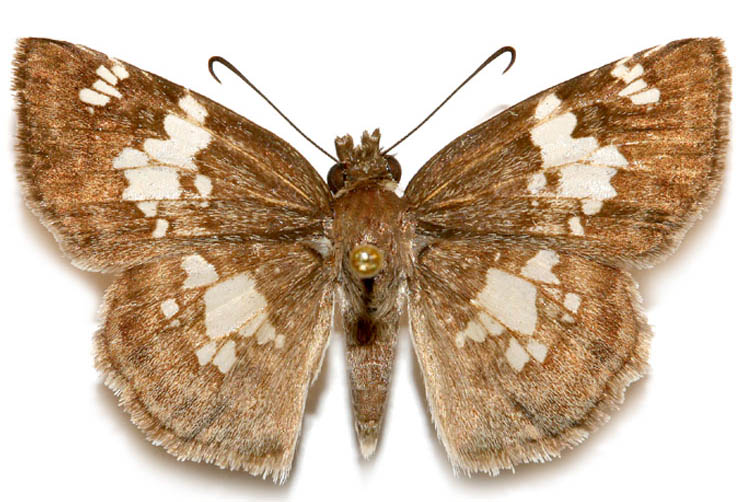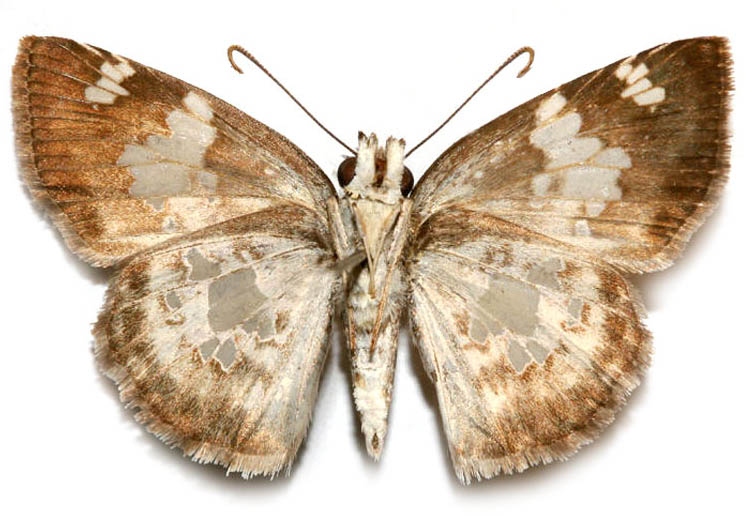by Steven J. Cary and Michael E. Toliver
Skippers (Hesperiidae). About a third of our butterfly fauna, more than 100 species, belongs to this family, which is subdivided into six subfamilies in the US: Eudaminae, Tagiadinae, Pyrrhopyginae, Pyrginae, Heteropterinae, and Hesperiinae. Of those six subfamilies, five are known from New Mexico and the sixth (Tagiadinae, represented by Celaenorrhinus fritzgaertneri) has been taken on the Arizona side of Cottonwood Canyon, Peloncillo Mountains. Therefore, it is likely that eventually all six will be known from our state. The tribe Megathymini has been considered a seventh subfamily, but recent genetic work (Li, et al, 2019) shows it belongs in the Hesperiinae. Skippers earned their name because of their rapid, skipping flight, which is powered by a heavily-muscled thorax. All skippers have antennal clubs that are distinctively bent, curved or hooked. Larvae silk leaves together for nests; larvae overwinter. Most subfamilies have distinct larval food preferences. Updated November 30, 2022
Dicot (aka Neotropical) Skippers (Hesperiidae: Eudaminae). The Eudaminae are a subfamily of skippers found largely in the Neotropics, but some have distributions that reach into temperate North America, including New Mexico. As a group, the Dicot Skippers have distinctly different behaviors, hostplants and appearances than other skippers. They resemble some Spread-wing Skippers (Pyrginae), but tend to be larger, rest with their wings over their backs in more typical “butterfly” fashion, and often have the hindwing anal angle produced, sometimes into a long “tail.” As the name implies, their larval foodplants are dicotyledonous plants (i.e., not grasses). Most larvae eat legumes (Fabaceae). This group was traditionally placed as a tribe (Eudamini) within the subfamily Pyrginae, but recent molecular DNA evidence prompted its elevation to subfamily status and resulted in considerable taxonomic re-arrangement among member genera and species. The new arrangement per Pelham (2019) will be different from arrangements in older guidebooks. New Mexico has at least 16 species from this subfamily.
- White-fringed Cloudywing (Cecropterus albociliatus) Coyote Cloudywing
- Dorantes Longtail (Cecropterus dorantes) Urbanus
- Desert Cloudywing (Cecropterus casica) Achalarus
- Dobra Cloudywing (Cecropterus dobra) Thorybes (mexicana) nevada
- Southern Cloudywing (Cecropterus bathyllus) Thorybes bathyllus
- Rocky Mountains Cloudywing (Cecropterus rockiensis) Northern Cloudywing [Cecropterus (Thorybes) pylades]
- Whitewashed Cloudywing (Cecropterus albosuffusa)
- Drusius Cloudywing (Cecropterus drusius)
- Brown Longtail (Spicauda procne) Urbanus
- Long-tailed Skipper (Urbanus proteus)
- Golden-banded Skipper (Telegonus cellus) Sonoran Banded Skipper, Cecropterus pseudocellus, Autochton
- Silver-spotted Skipper (Epargyreus clarus)
- Huachuca Skipper (Epargyreus huachuca) Sonoran Skipper
- White-striped Longtail (Chioides albofasciatus) Chioides catillus
- Zilpa Longtail (Chioides zilpa)
- Arizona Skipper (Codatractus arizonensis)
- Short-tailed Skipper (Zestusa dorus)
- North American Polygon (Polygonus arizonensis) Polygonus leo
- Acacia Skipper (Cogia hippalus)
- Yellow-costa Skipper (Cogia moschus) Gold-costa Skipper (Cogia caicus)
- Outis Skipper (Cogia outis)
- Xenophanes ruatanensis)
Cecropterus albociliatus (Mabille, 1877) White-fringed Cloudywing (added February 19, 2024)
Description. White-fringed Cloudywing begins a series of very similar skippers found – or likely to be found – in southwest New Mexico. It is larger than most skippers, with a dark, relatively unmarked upper surface. There may be a series of very pale spots on the forewings; one at the end of the cell and a series of submarginal spots from the upper margin to near the terminal margin. If present, they will be most obvious on the underside. Fringes of the hindwing and the lower part of the forewing are white. The unmarked hindwing has a slightly produced tornus. Range and Habitat. White-fringed Cloudywing is Mexican and Central American, but it occasionally strays into the southwest. Bailowitz & Brock (2021) noted only three SE Arizona records, but one of those is from the Arizona side of Guadalupe Canyon, so that is the place to look for it in New Mexico’s Bootheel. Life History. Bailowitz & Brock (2021) note the food plant in Sonora is Pithocellobium dulce (Fabaceae). That plant is often planted as an ornamental, though its native range is western Mexico. Flight. The three records from Arizona range from June – August. In its native range it probably flies year-around. Comments. There is another skipper, the Coyote Cloudywing, which may also be found in the Southwest someday, especially given our warming climate. Male Coyote Cloudywings have a costal fold on the forewing, which White-fringed lacks. Genitalic examination may be necessary to separate White-fringed from Coyote and other members of this group. Otherwise, White-fringed Cloudywings most resemble the Desert Cloudywing, but that species has prominent markings on the forewings. As noted above, the White-fringed Cloudywing has yet to be found in New Mexico, but its occurrence downstream in Guadalupe Canyon suggests it will be found here eventually.

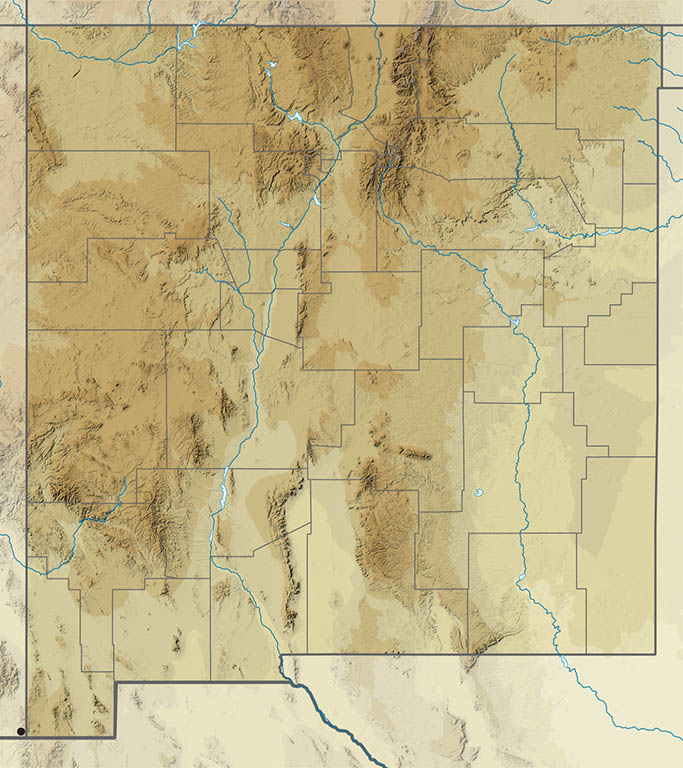
Cecropterus dorantes (Stoll 1790) Dorantes Longtail (updated July 31, 2022)
Description. This is one of a handful of long-tailed, subtropical skippers that wander into New Mexico from the south, but only occasionally. Wing fringes are checked. Forewing light spots are gold. The underside is banded brown and violet with irregular postmedian bands. Dorantes resembles the Long-tailed Skipper (Urbanus proteus) but lacks the iridescent blue-green scaling of that species and the arrangement of spots on the DFW are different. Range and Habitat. Cecropterus dorantes occurs south to subtropical South America. The few New Mexico records are for Upper Sonoran Zone canyons in our southwest quadrant between 4400 and 6000′ elevation (counties: Hi,Ot,Si). Life History. In nearby southeast Arizona, Bailowitz and Brock (2022) reported seeing Dorantes Longtail larvae on Desmodium neomexicanum, Desmodium batocaulon and Clitoria mariana (all Fabaceae). Raymond VanBuskirk photographed an ovipositing female in the southern Peloncillo Mountains on August 9, 2020, documenting seasonal reproduction here, as well. Flight. New Mexico records span August 1 to October 21, indicating an association with the summer thunderstorm season. Look for adults perching and nectaring at flowers in riparian settings. Comments. Li, et. al, (2019) moved this species from the genus Urbanus based on DNA and morphological considerations.
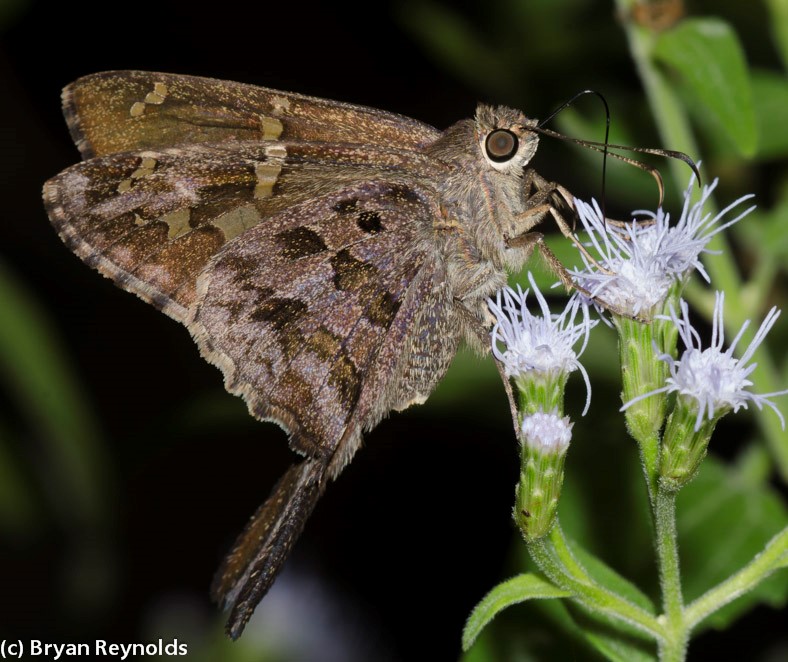
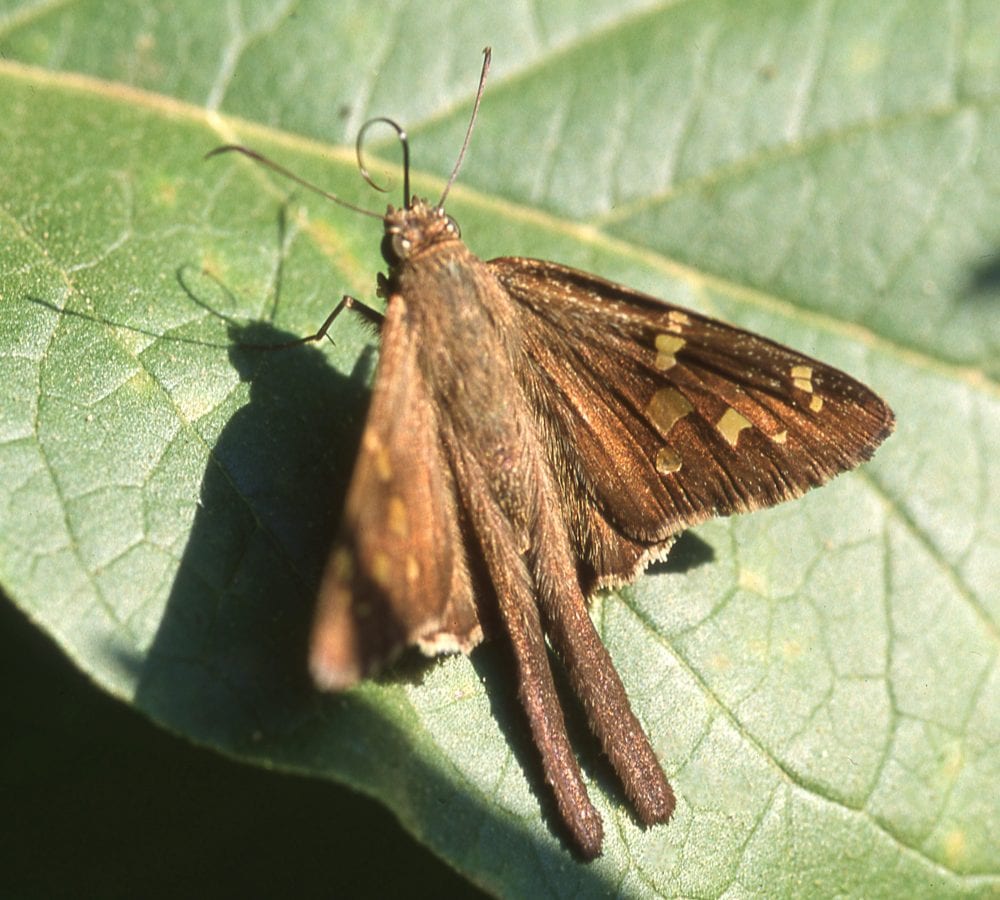

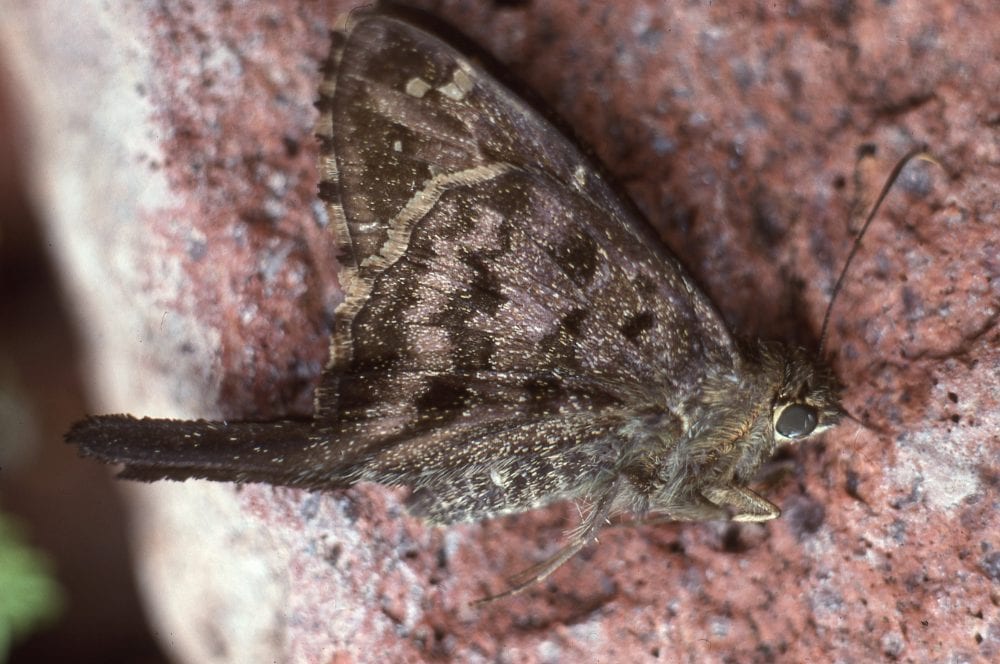
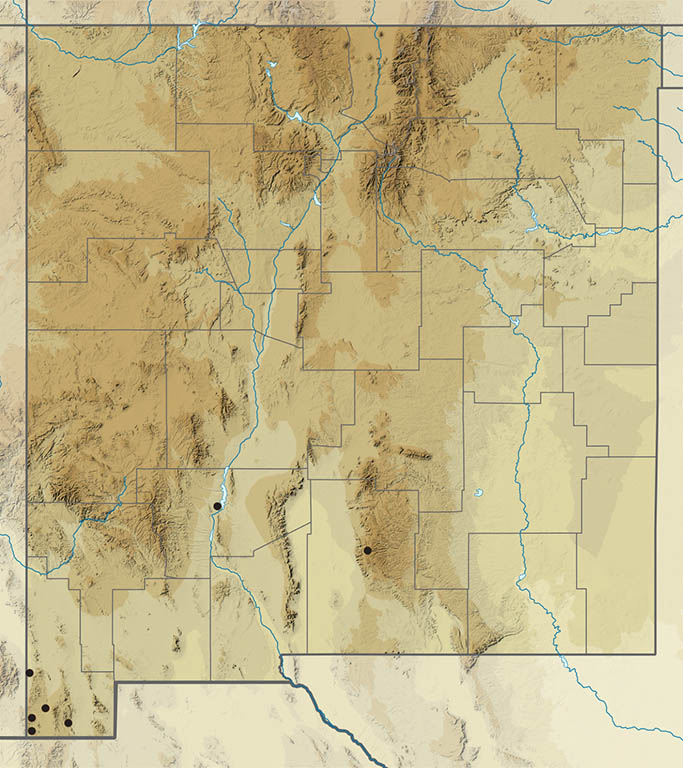
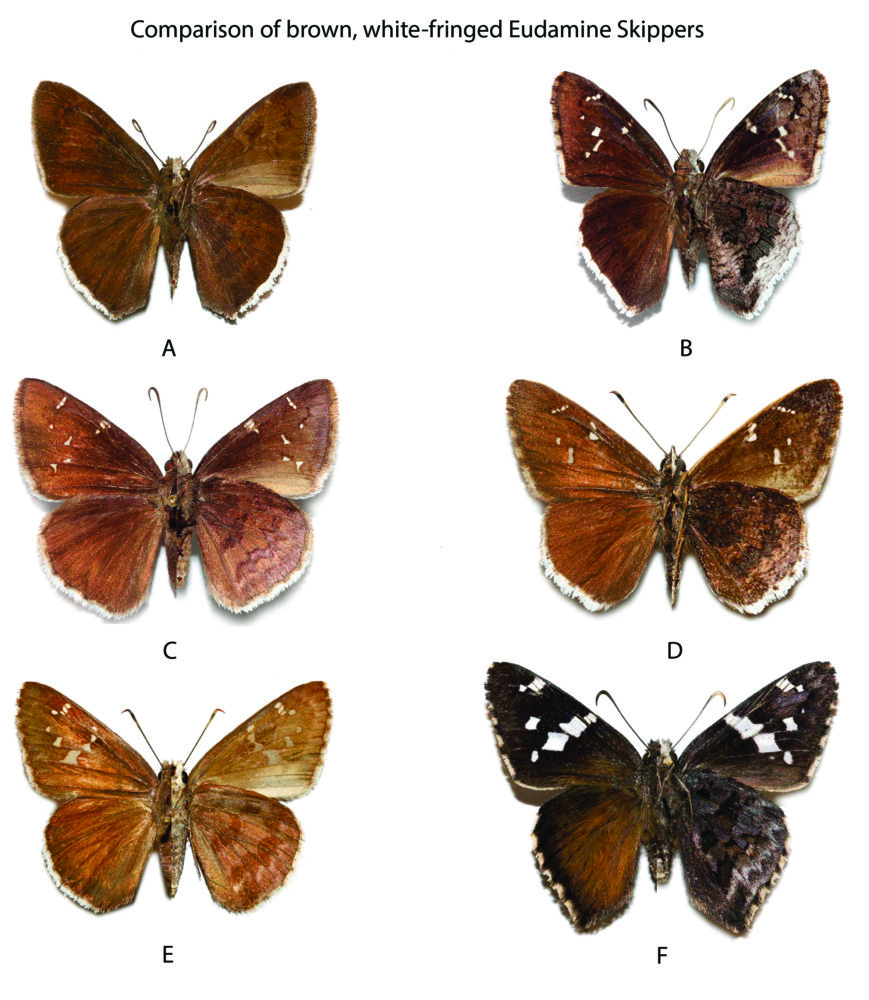
Cecropterus casica (Herrich-Schäffer 1869) Desert Cloudywing (updated July 21, 2022)
Description. The upperside pattern of white spots on a brown ground resembles other cloudywings, but the large white marginal patch on the VHW is reminiscent of Codatractus arizonensis. In combination, they are unique. There are a number of white-fringed brown skippers which are or may be found in southern New Mexico, and they can be confusing to separate, especially when looking at photos. Often, one can’t get a good look at both ventral and dorsal surfaces, and that inability precludes accurate identification. A comparison plate is provided to aid in determination in these difficult cases. Range and habitat. This skipper ranges from Guerrero, Mexico, north to southern Arizona, south Texas and southwest New Mexico (counties: Gr,Hi,Lu). It is found in Upper Sonoran Zone canyons, from 4500 to 6000′ elevation, but never in numbers. Life history. Various legumes (Fabaceae) serve as larval hosts. Bailowitz and Brock (2022) documented Desmodium cinerascens, D. batocaulon and Clitoria mariana as larval hosts in southeast Arizona. Flight. Although scarce in New Mexico, this skipper may breed here on occasion. Our few records are for the summer rainy season, July 4 to late September, but an additional spring generation occurs in southeast Arizona. Adults stop for nectar (e.g., honeysuckle) and mud as they patrol up and down riparian corridors. Comments. Li, et al., (2019) moved this species from the genus Achalarus. In their paper, Li, et al., noted the remarkable convergence of appearance in otherwise relatively unrelated species. The Desert Cloudywing is a member of such a group.
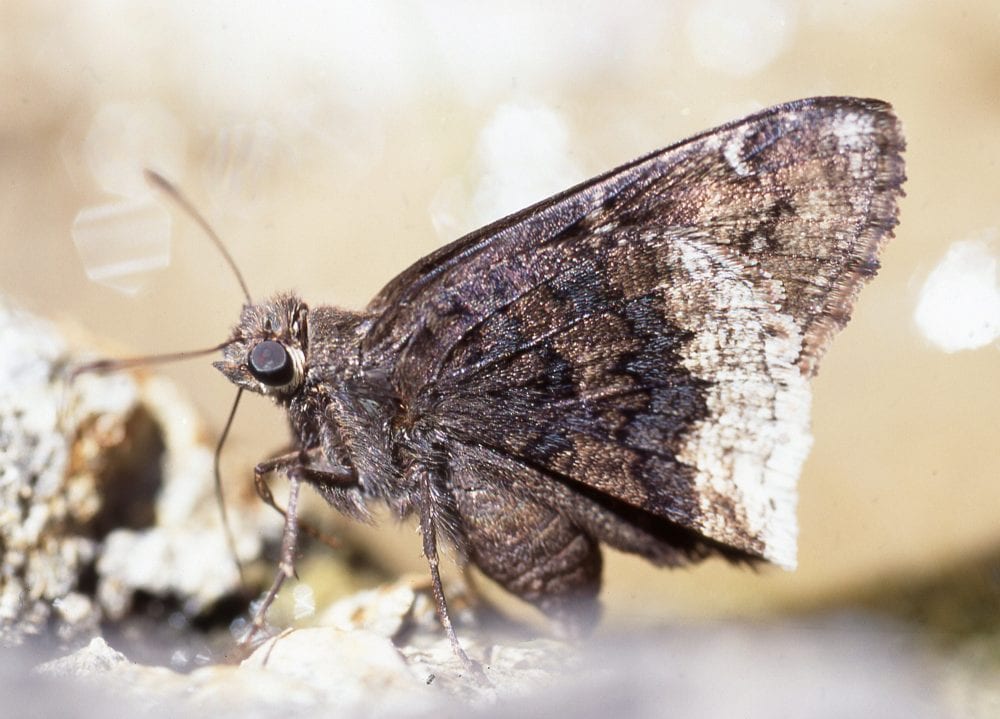
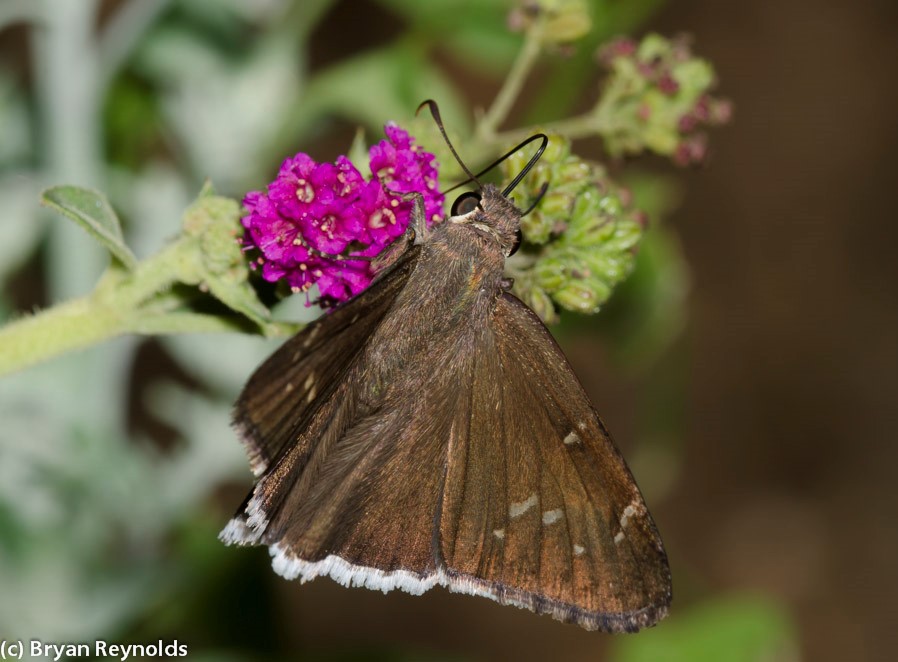
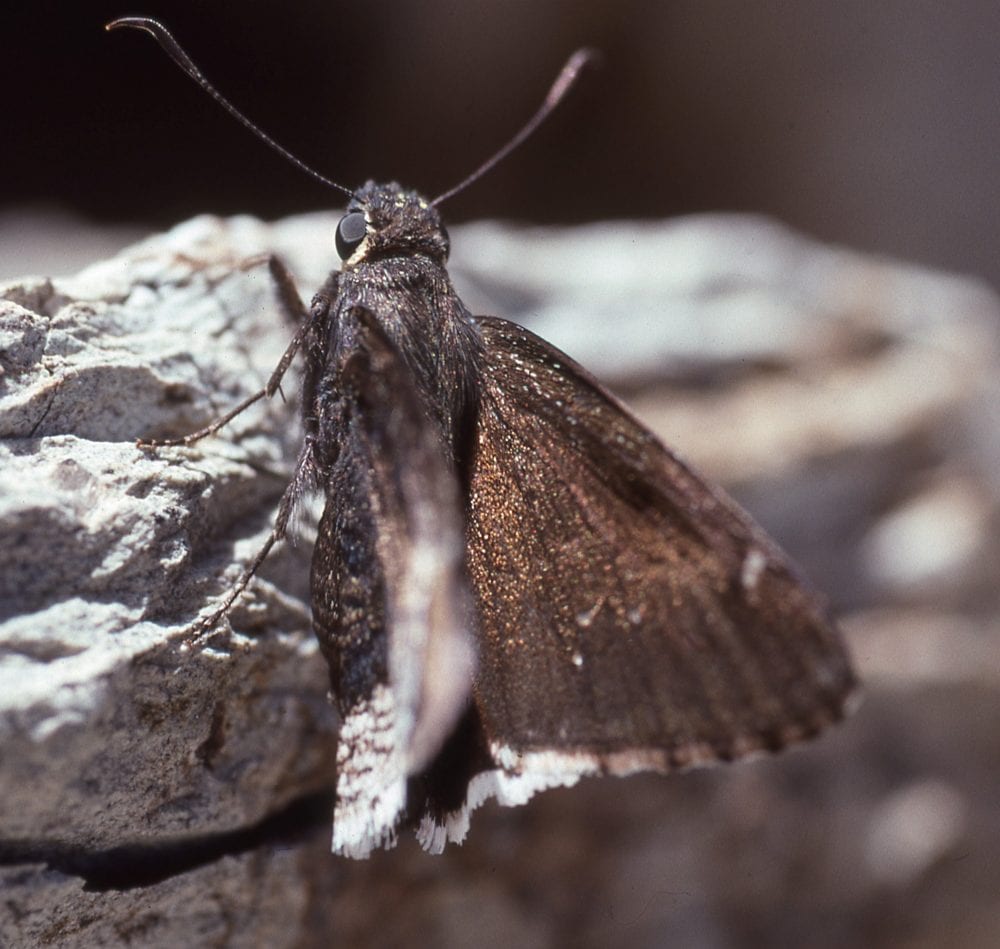
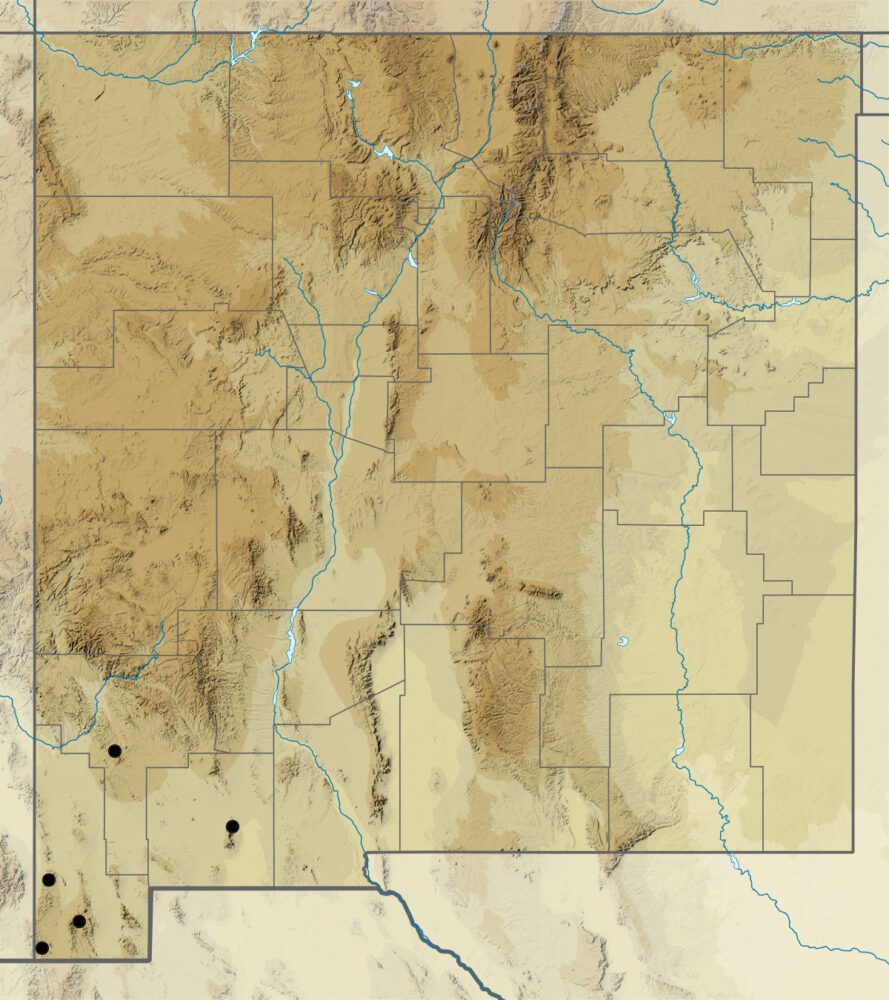
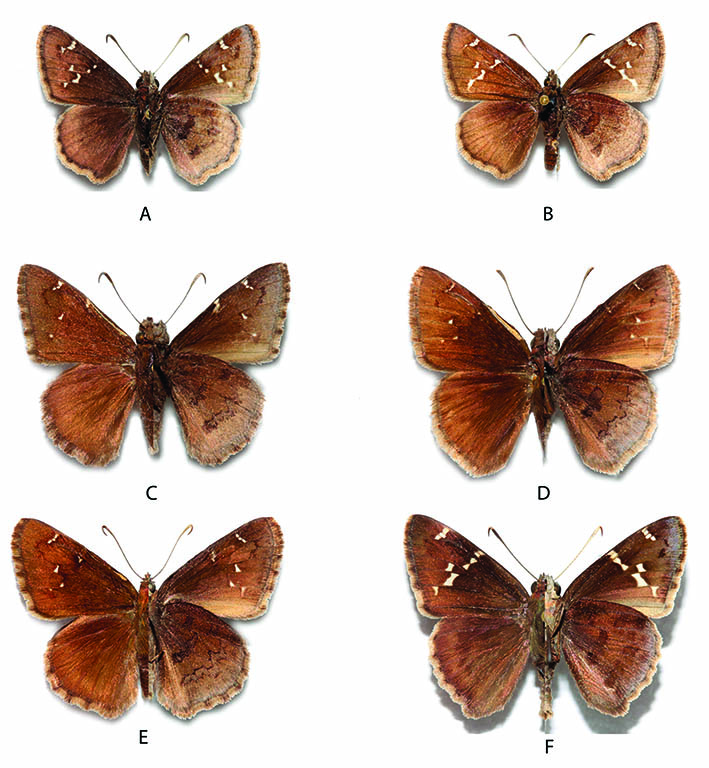
Cecropterus dobra (Evans 1952) Dobra Cloudywing (updated March 16, 2023)
Description. Dobra Cloudywing is the first of a two-species complex whose members often fly together and are difficult to differentiate, especially from the upperside alone. Compared to Northern Cloudywing (below) Dobra is smaller, the pale tan/tawny ventral hindwing has densely-packed dark striations, and males lack a costal fold. Range and Habitat. Dobra Cloudywing occupies inland western Cordillera from Idaho south to New Mexico. Here it inhabits Canadian Zone and Hudsonian Zone grasslands usually 7500 to 10,500′, but sometimes higher (counties: Be,Ca,Ci,Co,Gr,LA,Li,Mo,Ot,RA,Sv,SJ,SM,SF,Ta). Life History. Larvae eat legumes (Fabaceae). Scott (1992) reported oviposition on Trifolium rusbyi and Vicia americana at Hopewell Lake, 9800′ (RA).Bailowitz and Brock (2022) reported oviposition on Lathyrus arizonicus in northern Arizona. Use of other legumes is possible. Flight. In southern NM, Adults fly from April 21 to July 5, mainly in June. In northern NM, adults fly from April 21 to August 16, mainly in June and July. Males defend hilltop perches. Both sexes go to nectar and water. Comments. This species complex recently underwent a DNA-driven taxonomic overhaul in which regional populations previously classified as subspecies were proposed as full species. Populations in northern New Mexico mountains, previously treated as Thorybes (mexicana) nevada (Scudder 1872) now belong to Cecropterus dobra.
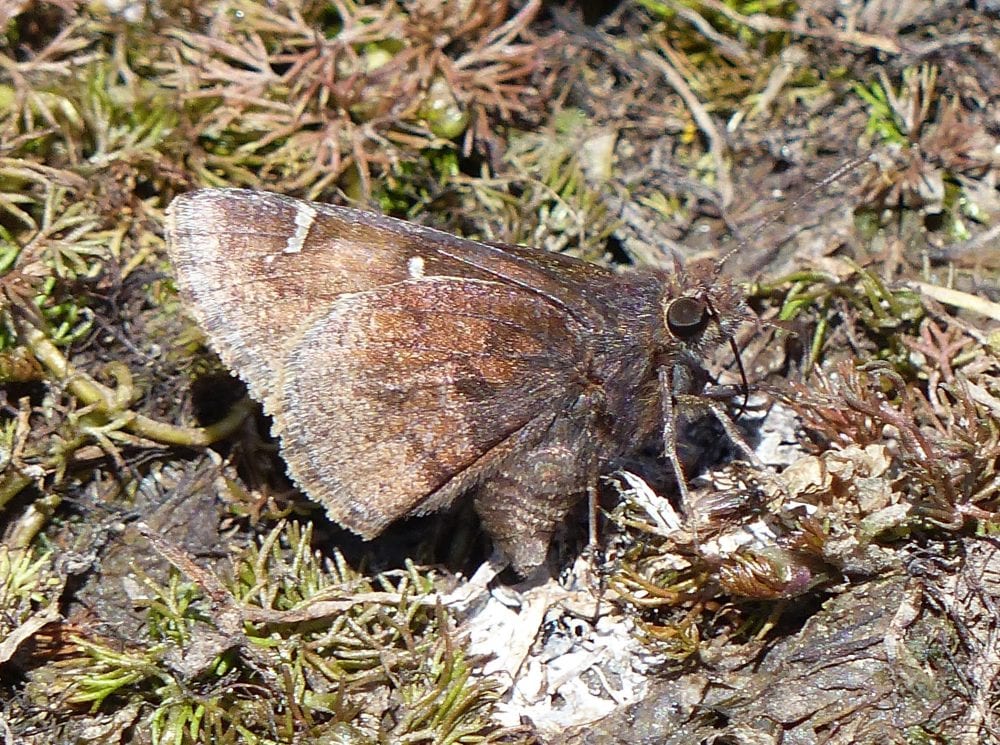
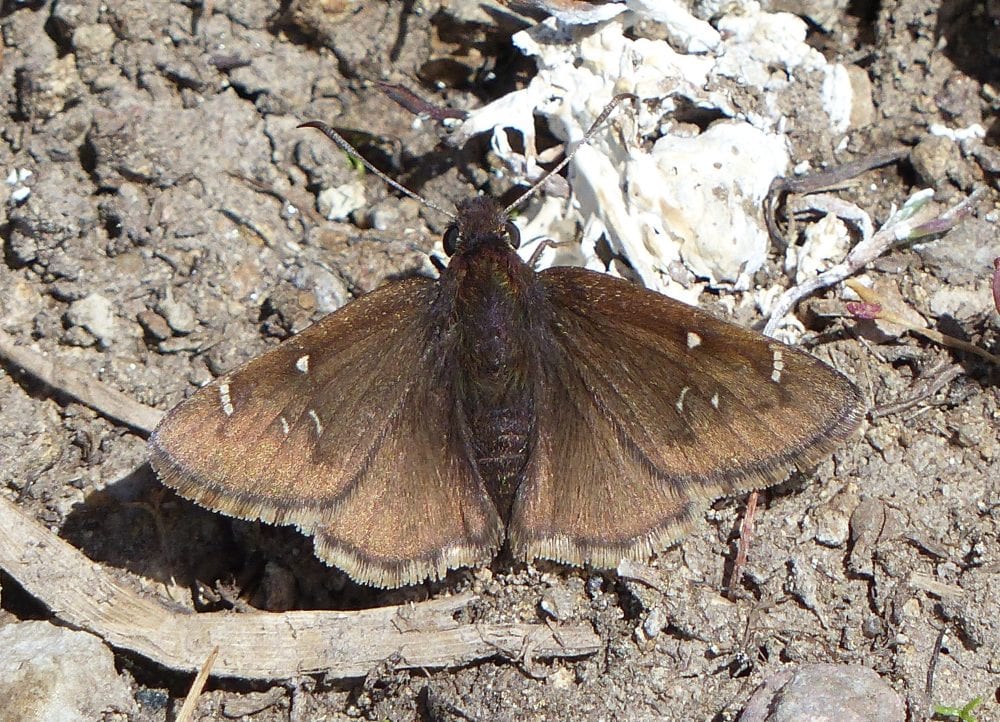
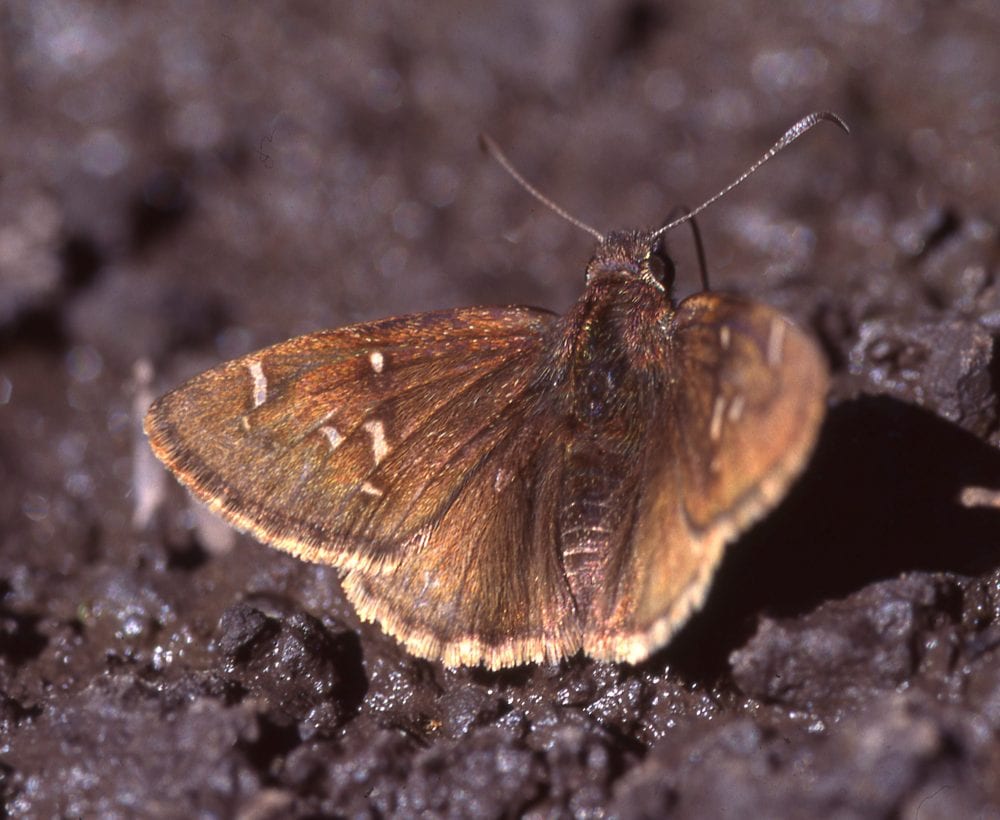
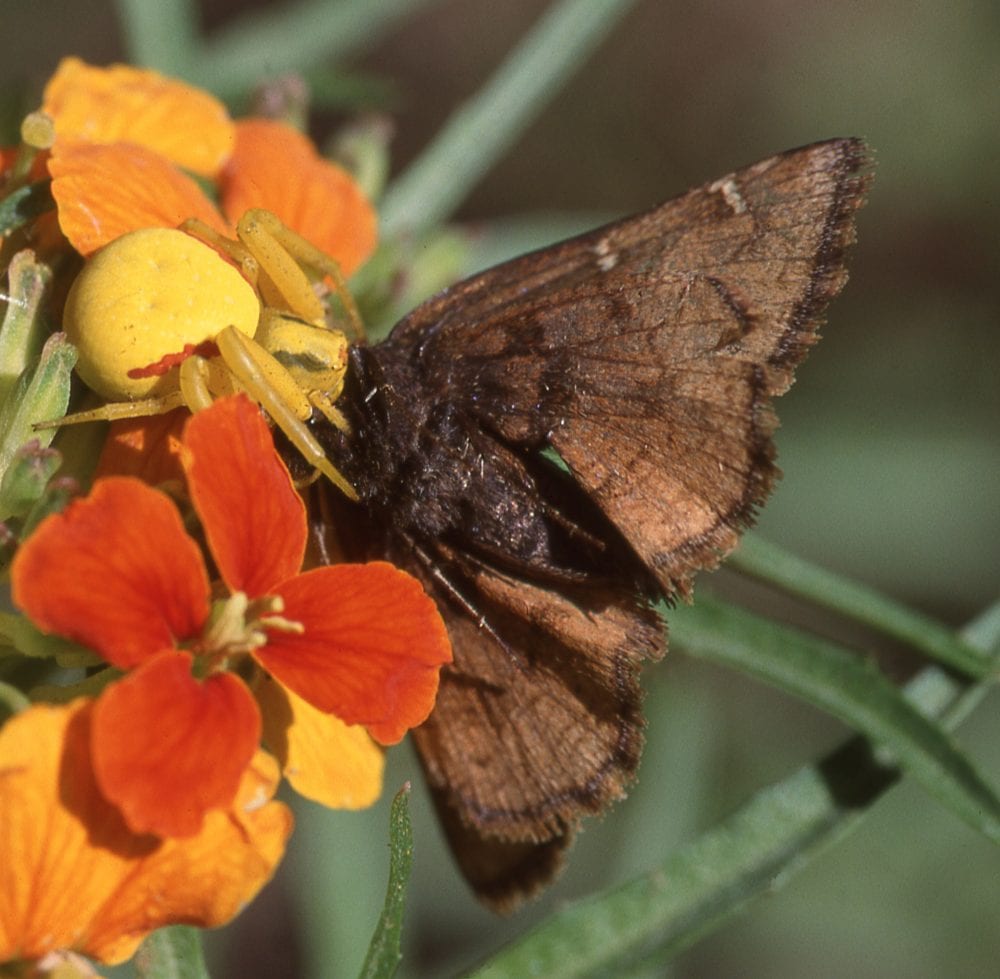
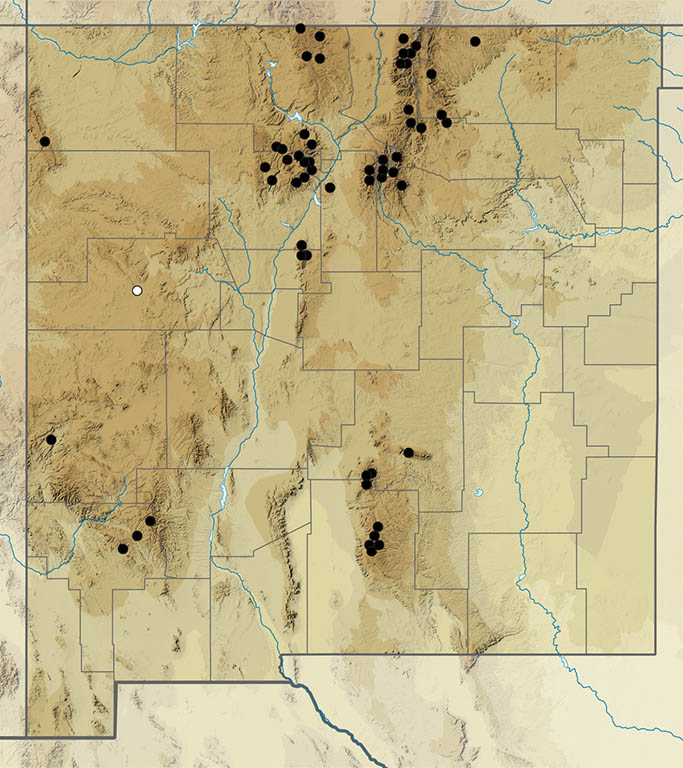
Cecropterus bathyllus (J. E. Smith, 1797) Southern Cloudywing (updated June 30, 2025)
Description. The Southern Cloudywing is as large as the Northern Cloudywing. It tends to be darker brown than the other similar species, and the white spots on the FW are larger. Those spots are aligned in a diagonal line, which distinguishes this critter from the Northern Cloudywing. The DHW fringes are whitish and unmarked. The VHW resembles the Northern Cloudywing. Males lack a costal fold. Range and Habitat. This is primarily an eastern US species, particularly in the SE US. It is dubiously reported from NM (10 mi. N. of Jemez Springs, 16-vii-1950, Sv), based on likely misidentification of the AMNH specimen. However, the species has been recorded from SE CO, so it may eventually be reliably recorded from our state. Life History. Larvae feed on various species of Fabaceae, including Trifolium, Lespedeza, Desmodium, and Astragalus. Flight. Our single report is from July, which is a typical time to find the species in most of its US range. In more northern areas, it has a single midsummer brood, but in southern areas it may have as many as three broods per year (June – October). Comments. Observers in eastern parts of NM should be on the lookout for this species, especially along river courses. Formerly Thorybes bathyllus.

Cecropterus rockiensis Grishin 2023 Rocky Mountains Cloudywing (updated February 20, 2024)
Description. Rocky Mountains Cloudywing is a medium-sized, gray-and-brown skipper. The white spotting above consists of relatively small spots, with the subapical group arranged in an arc-like pattern. The spots are not aligned, unlike the Southern Cloudywing. The ventral hindwing pattern differs from that of Cecropterus dobra, with no fine striations and the irregular darker bands more prominent. Dobra also is smaller and a hilltopper. Male rockiensis have a costal fold. Range and Habitat. This skipper occurs in the Rocky Mountains from Montana south to Arizona and New Mexico, where it is a resident in canyons and meadows. It is the prevalent cloudywing in northern and central New Mexico uplands below 9000′ (counties: Be,Ci,Co,Ha,LA,MK,Mo,Ra,Sv,SJ,SM,SF,Ta,To,Un). It is montane in southern New Mexico as well (counties: Ca,Gr,Li,Ot,Si,So), possibly flying as low as 6500′ elevation, but the details of its distribution are masked by our inability to distinguish C. rockiensis from C. albosuffusa based on phenotype alone. Life History. Larvae eat legumes (Fabaceae). Lathyrus leucanthus is used in Colorado (Scott 1992). Cologania angustifolia is used and Desmodium batocaulon is suspected in southeast Arizona (Bailowitz and Brock 2022). Flight. Rocky Mountains Cloudywing is univoltine in New Mexico mountains, peaking in June. Adults fly in topographically low areas and perch with wings partly open, whether feeding at flowers or wet sand. Comments. We called this deceptively continent-spanning insect Northern Cloudywing [Cecropterus (Thorybes) pylades] until October 2023, when Zhang et al. Oct. 2023 demonstrated that Rocky Mountains populations were genetically distinct and gave them the new name, rockiensis Grishin 2023. Individuals with washed out scaling in the ventral hindwing marginal area are somewhat regular in our southern tier of counties and may be Cecropterus albosuffusa (H. Freeman 1943).
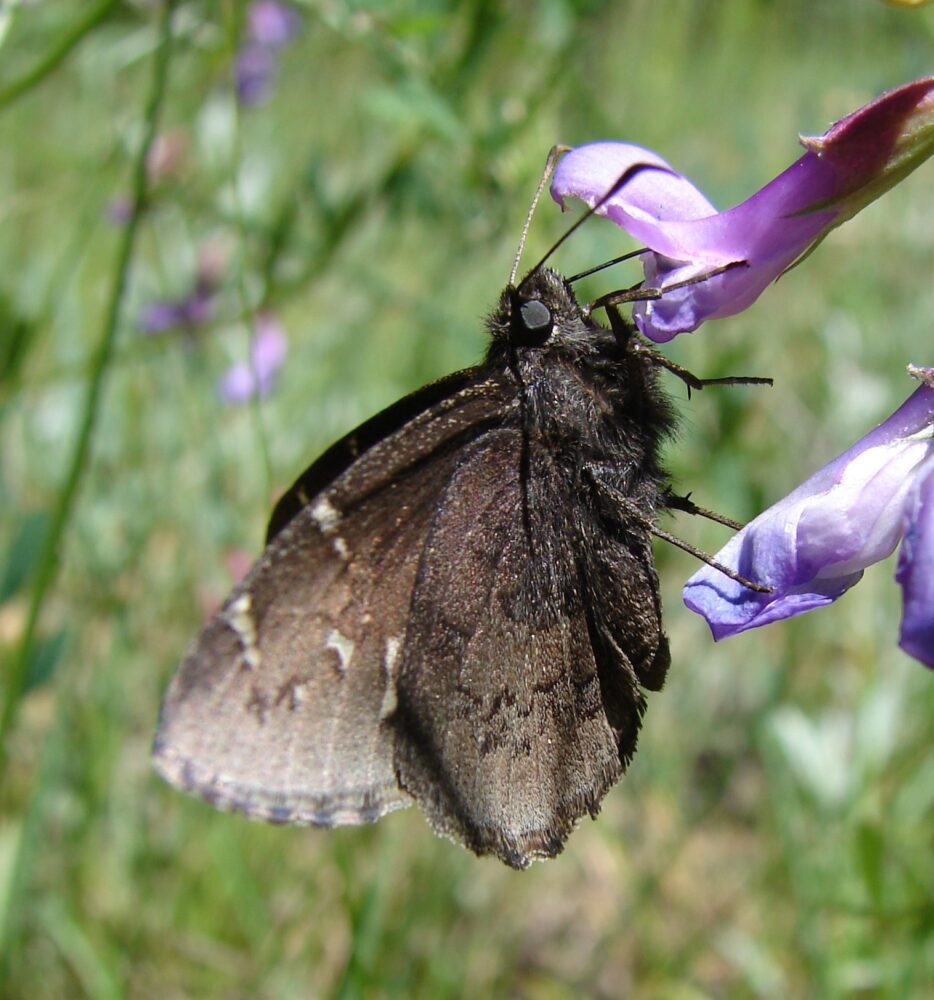
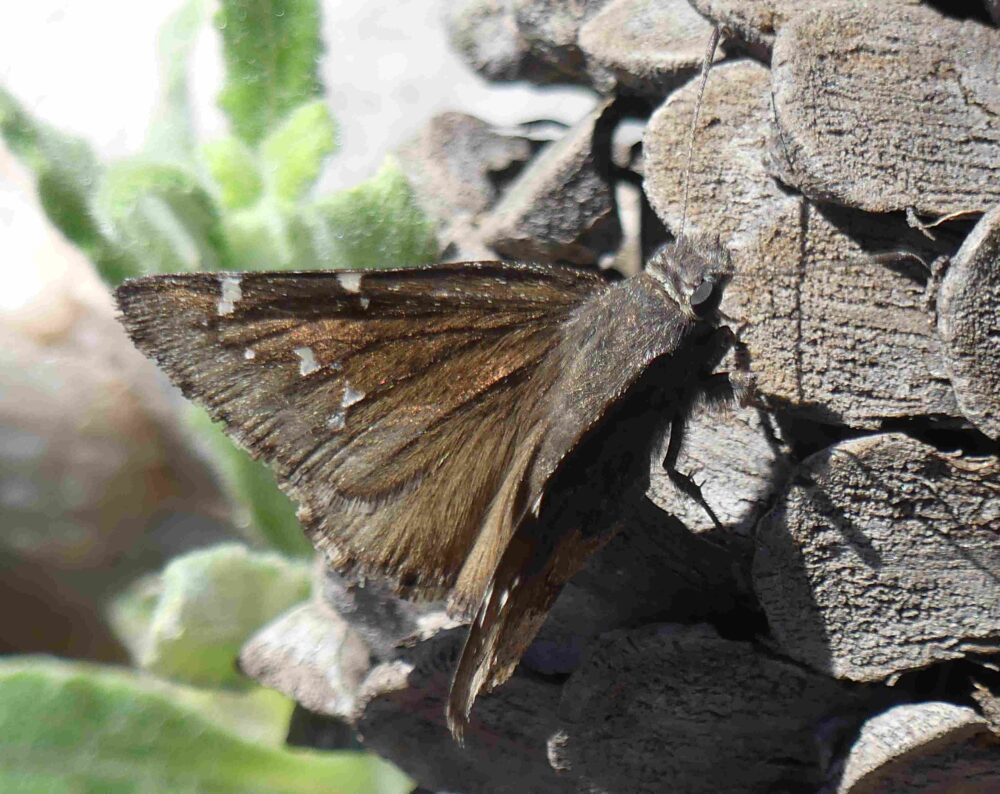
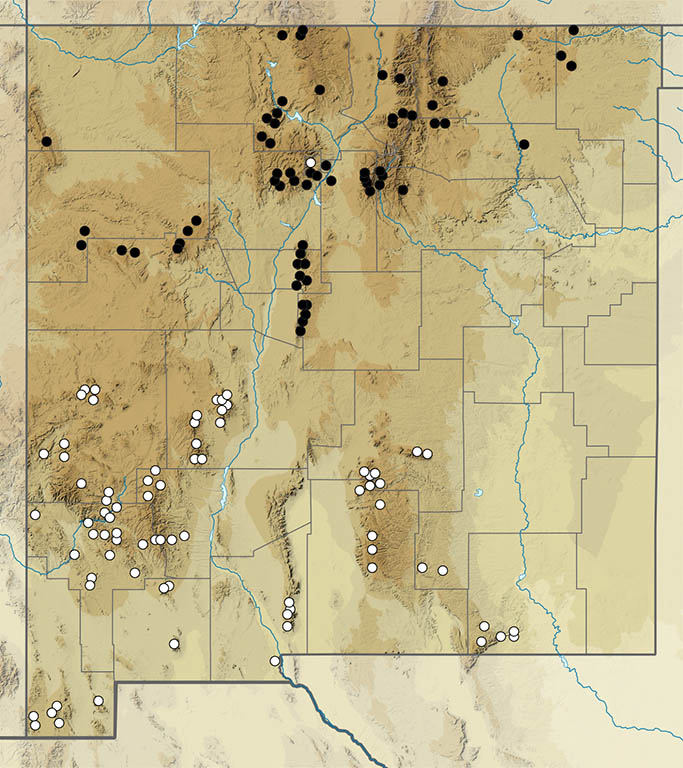
Cecropterus albosuffusa (H. Freeman 1943) Whitewashed Cloudywing (updated February 21, 2024)
Description. Of medium size and in most ways very much like Rocky Mountains Cloudywing, but usually with a wash of pale scales over distal portions of the VHW. The hind wing often has the tornus slightly produced in males, like C. bathyllus. The fringes are less prominently checkered. Males have a costal fold. Genitalia are apparently distinct. Range and Habitat. Northern Mexico, southern AZ, SW Texas into southernmost NM. Life History. As far as we know, albosuffusa has not been reared but we assume its larval hosts and immature stages are similar to those of rockiensis. Flight. Individuals that we tentatively identify as albosuffusa are recorded June – August in southern NM. Comments. In their analysis which determined genetically that this skipper is a species distinct from rockiensis, Zhang et al. (Oct. 2023) ran genomics on specimens from Arizona, Texas and Mexico, but apparently none from New Mexico. Therefore, we have no proof, merely educated speculation, that some of the cloudywings that thrive in southernmost NM are C. albosuffusa. Nevertheless, we will proceed as if it is a foregone conclusion. BOA includes a “southwestern segregate” (not further defined) and we suspect populations in our desert mountains will fit into that taxonomic cubbyhole when data become available. At a minimum, the northern edge of albosuffusa and the southern edge of rockiensis remain to be determined; both are likely to be in southern NM.
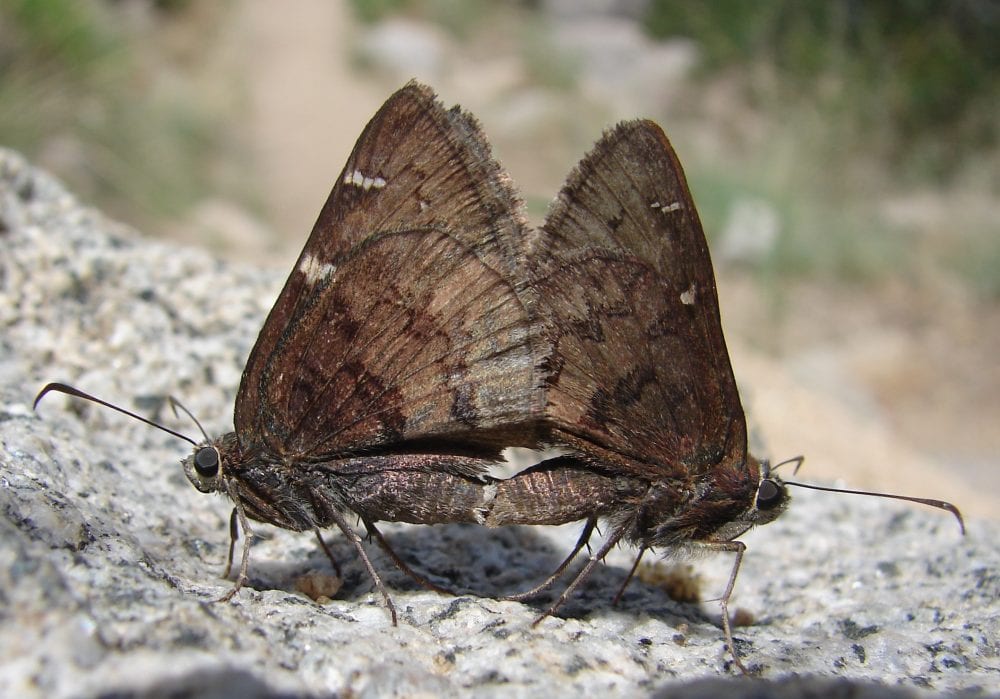
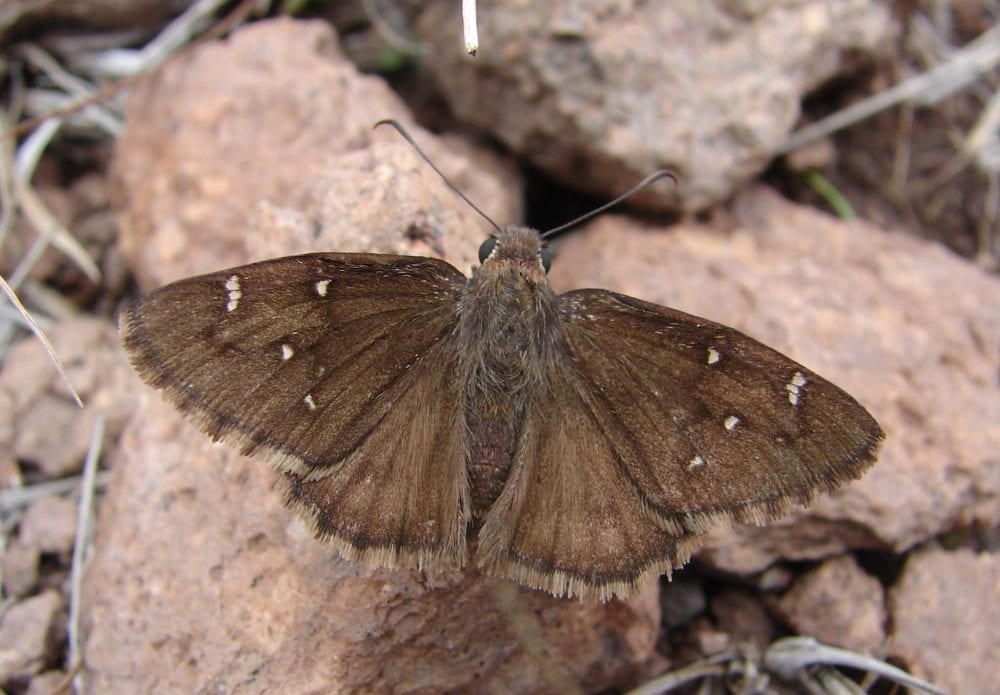
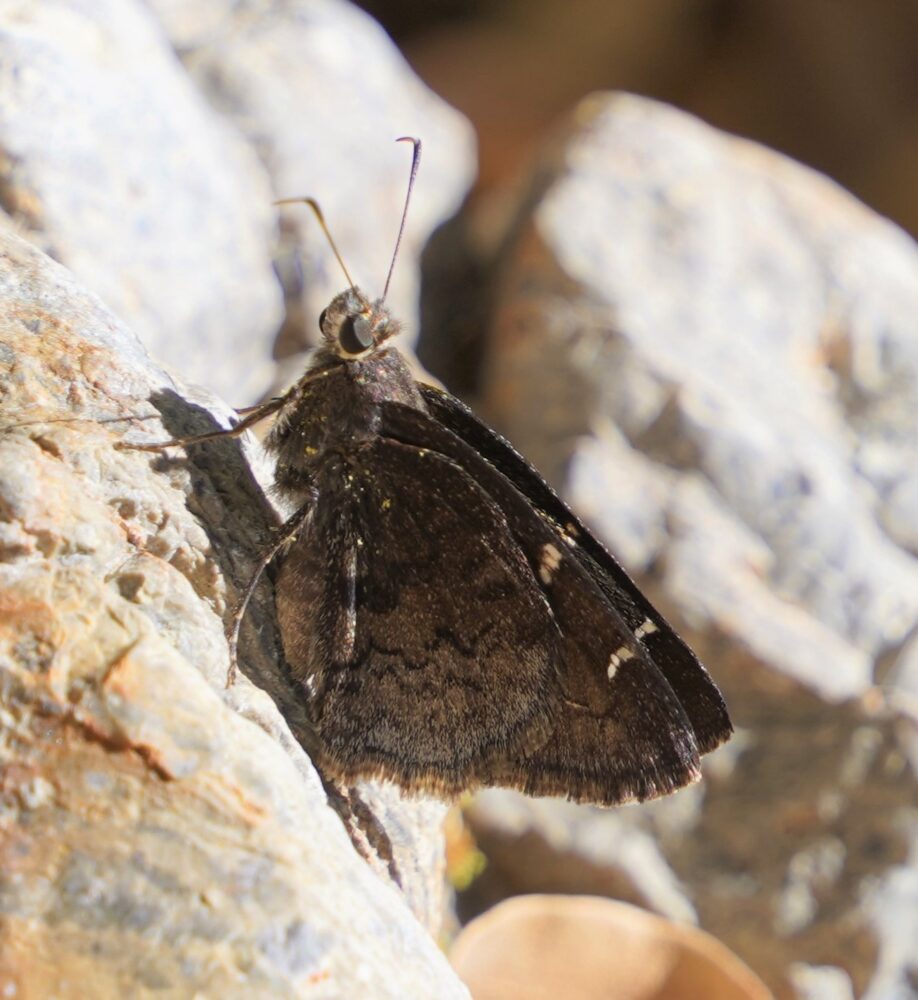
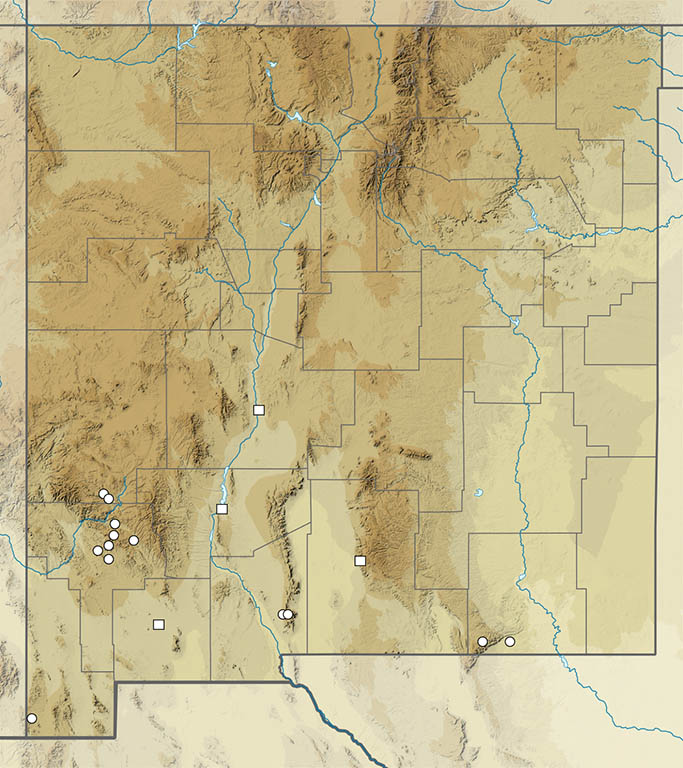
Cecropterus drusius (W. H. Edwards [1884]) Drusius Cloudywing (updated August 5, 2022)
Description. The white fringe on the hindwing is the main feature by which to distinguish Drusius from our other cloudywings. In addition, the forewing is more pointed and the dorsal forewing white spots are reduced. The ventral surface resembles the Northern Cloudywing, except for the white fringe. Drusius is about the size of Northern and thus is bigger than Dobra (the other Cloudywing that shares its range). Range and habitat. This skipper is resident from Guerrero, Mexico, north into southern Arizona and west Texas; it appears to stray rarely to southwest New Mexico (counties: Hi). Look for it in Upper Sonoran Zone canyons, open oak woodlands and grasslands. Life history. In southeast Arizona, Bailowitz and Brock (1991) reported larvae feeding on Cologania angustifolia (Fabaceae). Other legumes are also likely hosts. Little is known about this insect’s life cycle or occurrence in New Mexico. Flight. Our single record, dated August 24, suggests an occasional, weak influx coinciding with the summer rains.
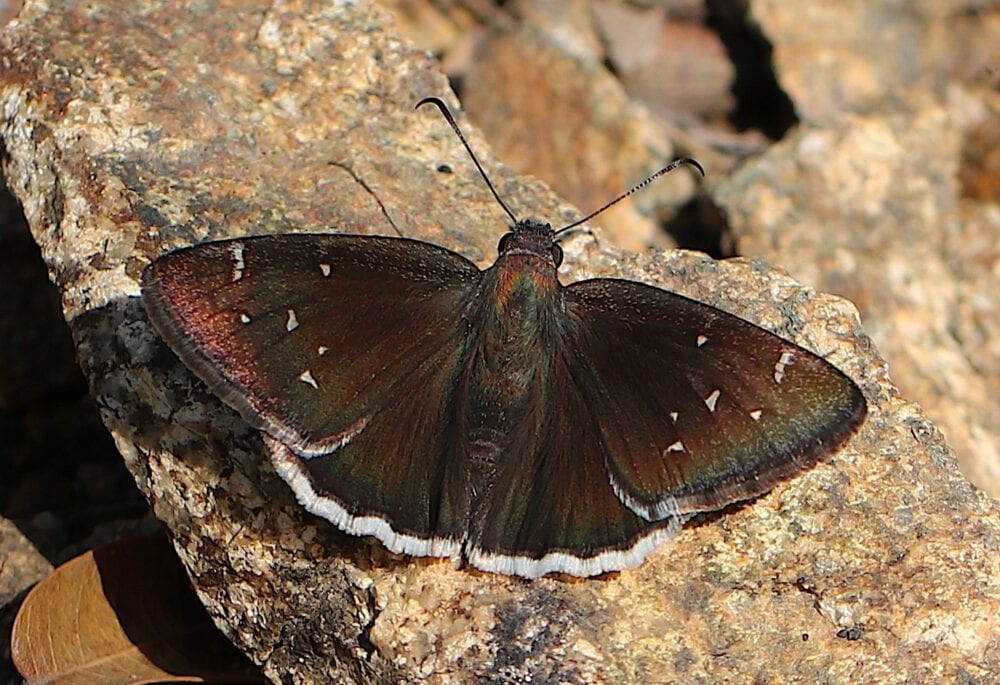
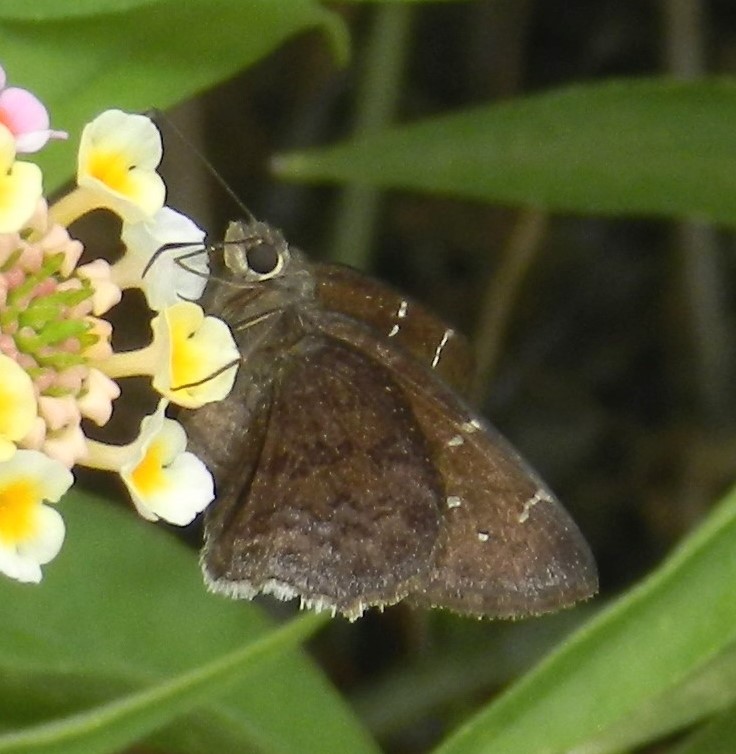
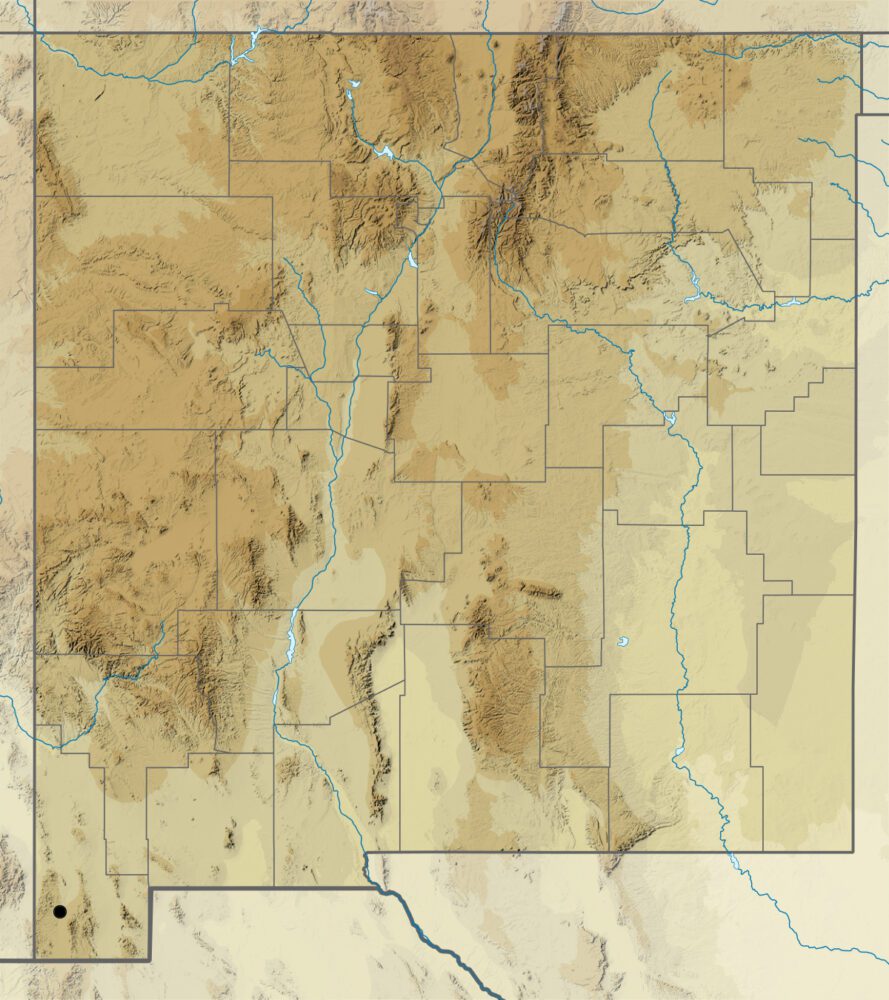
Spicauda procne (Plötz 1881) Brown Longtail (updated August 6, 2022)
Description. The Brown Longtail is easily separated from Long-tailed Skipper and Dorantes Longtail by its unchecked tan fringes and (in males) the lack of white spots on the forewing upperside. Some females have a narrow white postmedian band on the forewing, causing them to be mistaken at times for Spicauda teleus (Hübner). It also can be confused with Spicauda simplicius (Stoll), a rare stray to southeast Arizona. In some cases, genitalic examination may be needed to confirm identification. All are rare or currently unknown (but should be looked for) in New Mexico. Range and habitat. Our solitary report is from Cottonwood Canyon, Guadalupe Mountains (county: Hi), 23 September 1990, by Kilian Roever. Identity of this individual was recently confirmed via genomic analysis (Zhang et al., April 2, 20025). Life History. Unlike fellow Eudamines, larvae of this species apparently eat grasses (Poaceae)! For example, Jim Brock (1993, pers. comm.) observed oviposition on Cynodon dactylon in southeast Arizona. There is no evidence of reproduction in our area and its occurrence here is too infrequent to support breeding. Flight. Our single record suggests observers would be most likely to encounter this species during the late summer rains. Comments. Li, et al. (2019) moved this species from the genus Urbanus.
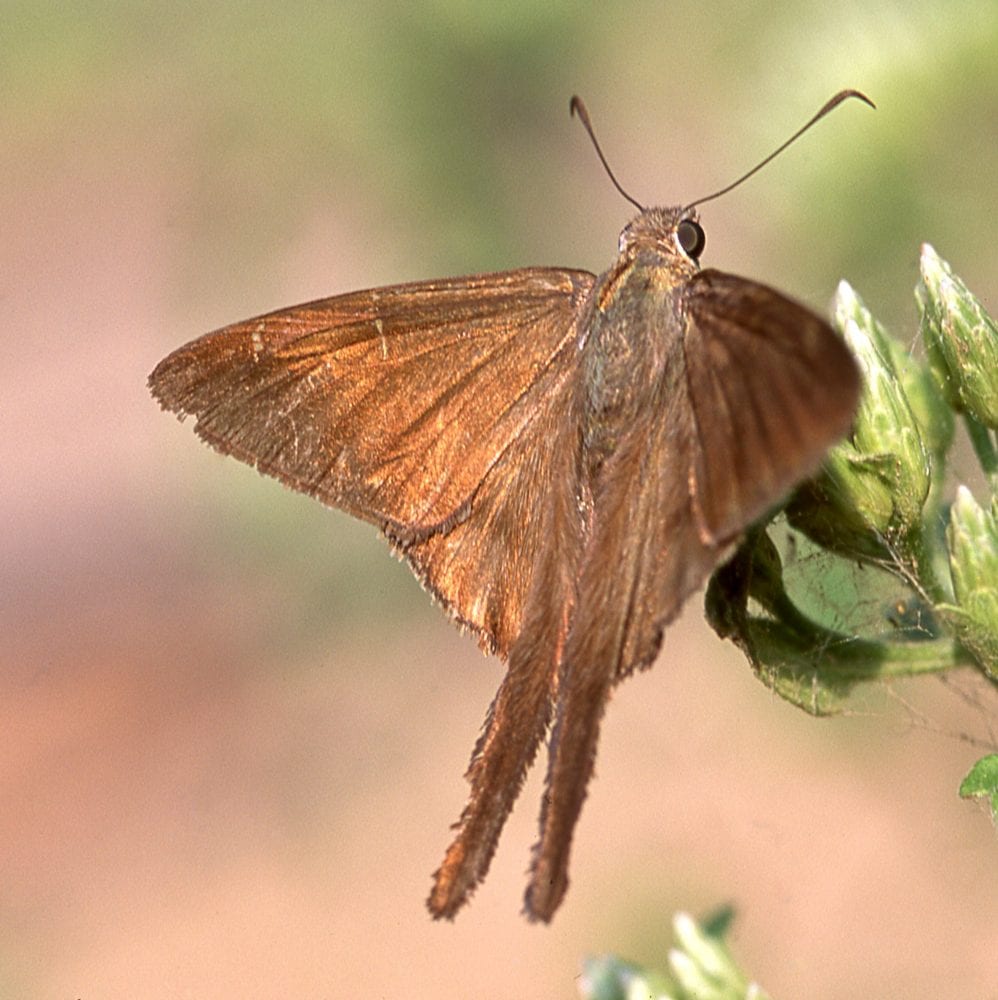

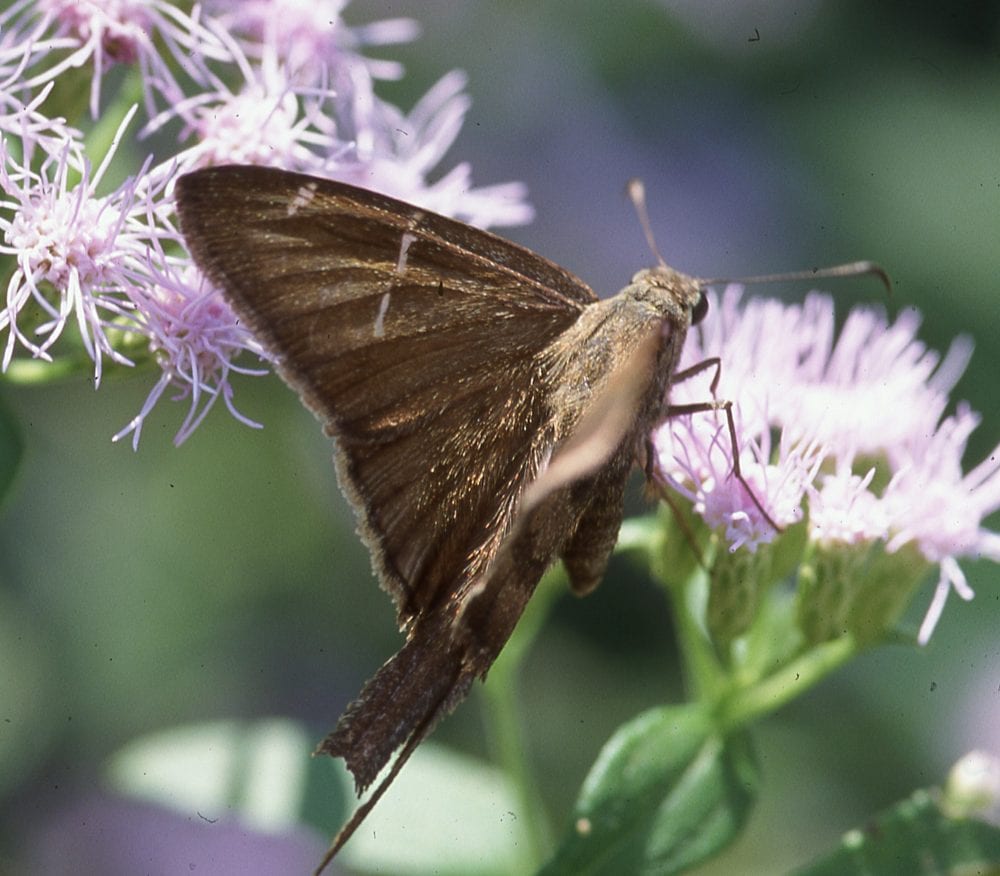
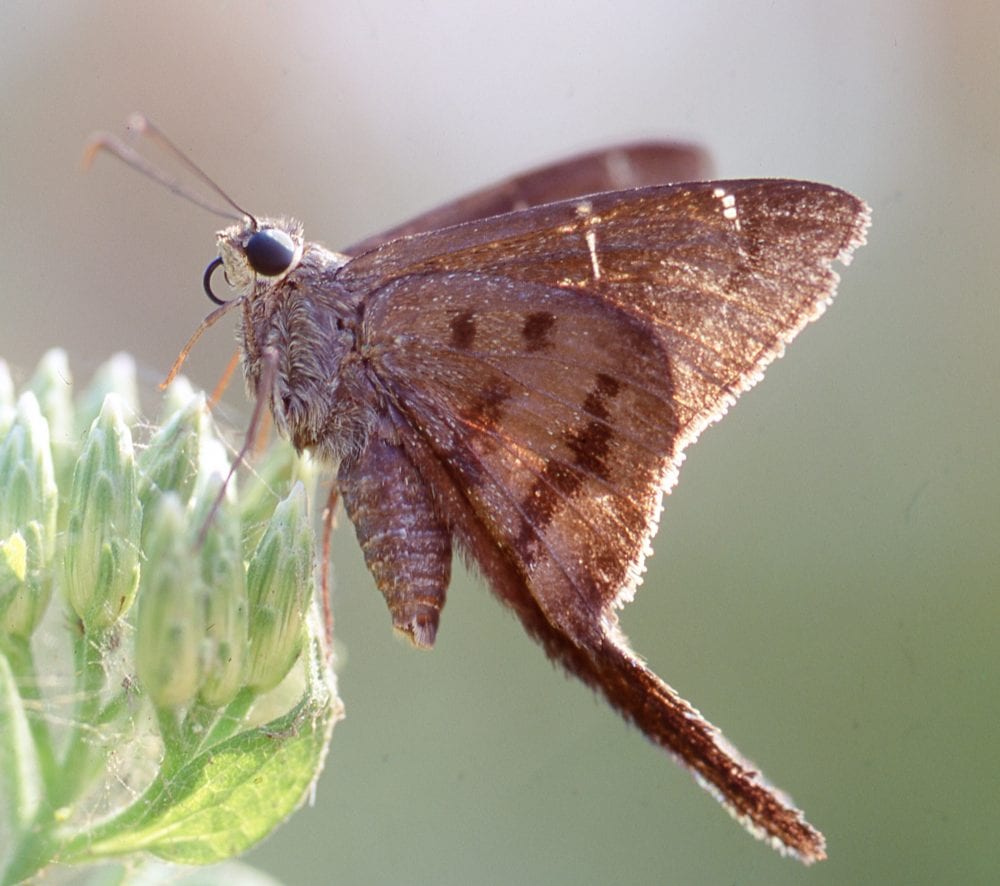
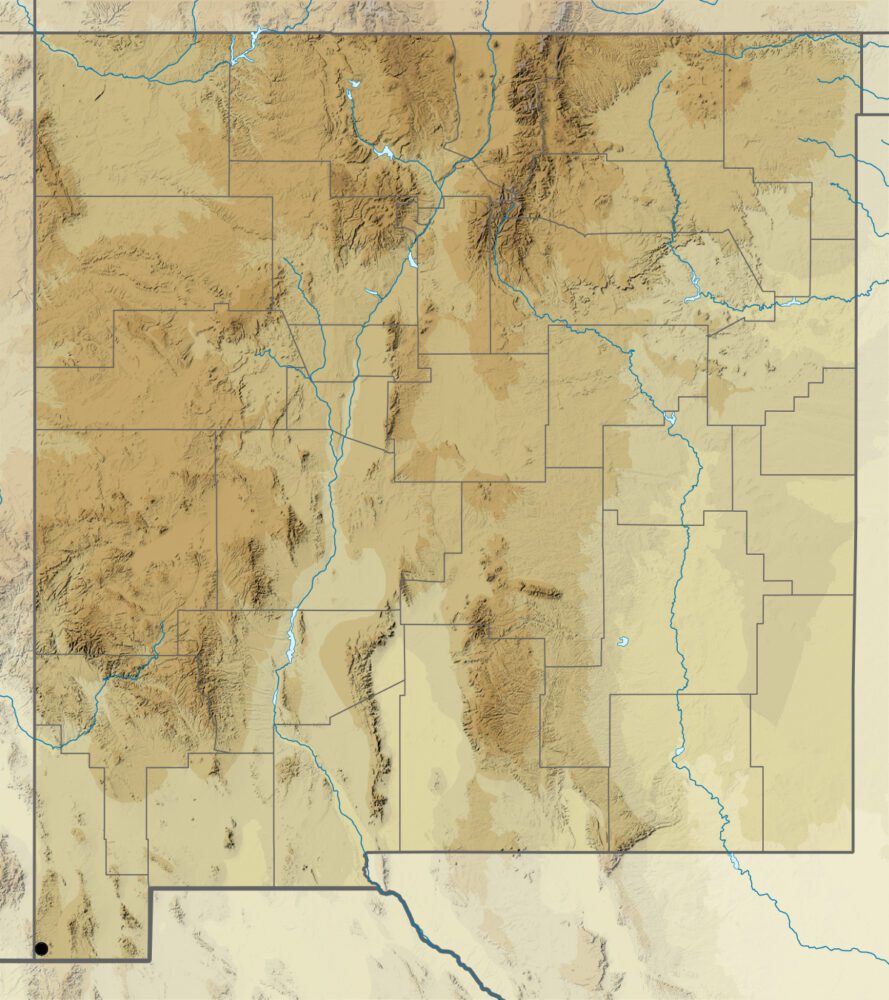
Urbanus proteus (Linnaeus 1758) Long-Tailed Skipper (updated August 13, 2022)
Description. Several subtropical skippers found or potentially found in NM have long hindwing tails, but only Urbanus proteus has blue-green scaling above. Forewing light spots are whitish. Ventral postmedian bands are smooth and straight. Range and habitat. This species lives along the west and east coasts of Mexico, extending north along the Gulf Coast of southeastern US as far as South Carolina. Strays wander inland occasionally, but only rarely to southwest New Mexico (county: Hi). Life history. Legumes (Fabaceae) are larval hosts. One larva was found on Desmodium batocaulon in southeast Arizona (Bailowitz and Brock 2022). Flight. Our reports, for September and October, represent stray occurrences. Comments. This butterfly can be a true migrant in the eastern US, exhibiting gradual northward movements in spring and summer, and a southward flight in fall (Scott 1986).

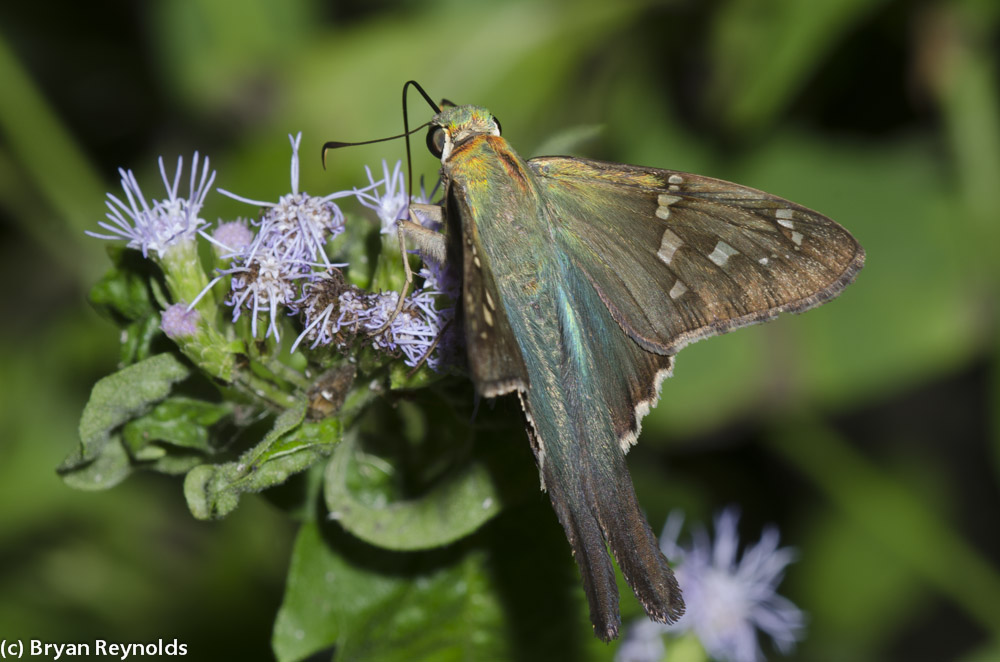
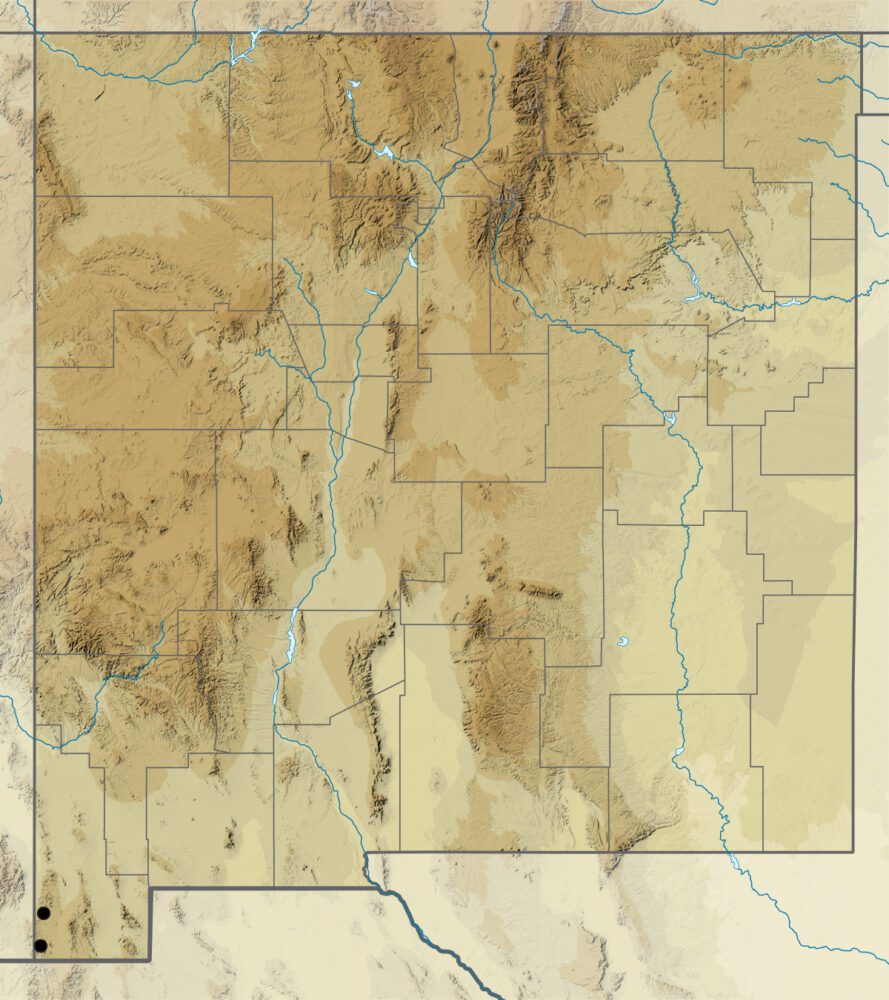
Telegonus cellus (Boisduval & Le Conte [1837]) Golden Banded-Skipper (updated August 11, 2022)
Description. The common name describes the most prominent feature of this skipper: a diagonal gold band traversing the forewing. Wing fringes are checked. Ventral surfaces are mottled and camouflaged. A very similar species, the Sonoran Banded Skipper, Cecropterus pseudocellus (Coolidge & Clemence, [1910]), was discovered in SE Arizona at the beginning of the 20th century but has not been found there since 1937 (Bailowitz & Brock 2022). There is a slim possibility that this species could turn up in SW NM. It is distinguished from the Golden Banded-Skipper by its smaller size, narrower gold band on the FW, more checkered fringes, and a white ring around the antenna. Range and Habitat. In New Mexico this beautiful skipper resides in Upper Sonoran and Transition Zone canyons (5500 to 8500′) in our southwest corner (counties: Ca,Gr,Hi,Si). It also is found south well into Mexico and in the southeastern US. Life History. Scott (1986) reported larval hosts in our area to be legumes (Fabaceae) such as Phaseolus wrightii, P. grayanus, Clitoria mariana and Vigna species. Bailowitz and Brock (2022) reported use larval use of Robinia neomexicana and Phaseolus ritensis as well as Desmodium batocaulon (all Fabaceae). Pupae overwinter. Flight. Golden Banded-Skippers have one annual generation that flies here between May 27 and September 9, primarily July and August. Males perch on shrubs along creeks and patrol up and down drainage corridors in search of females. Adults take nectar and electrolytes at streamsides. Comments. Kansas Professor F. H. Snow made the first New Mexico observation of Telegonus cellus along Walnut Creek, 12 miles north of Silver City (Gr) in August 1884. Pelham (2019) moved this species from the genus Autochton.
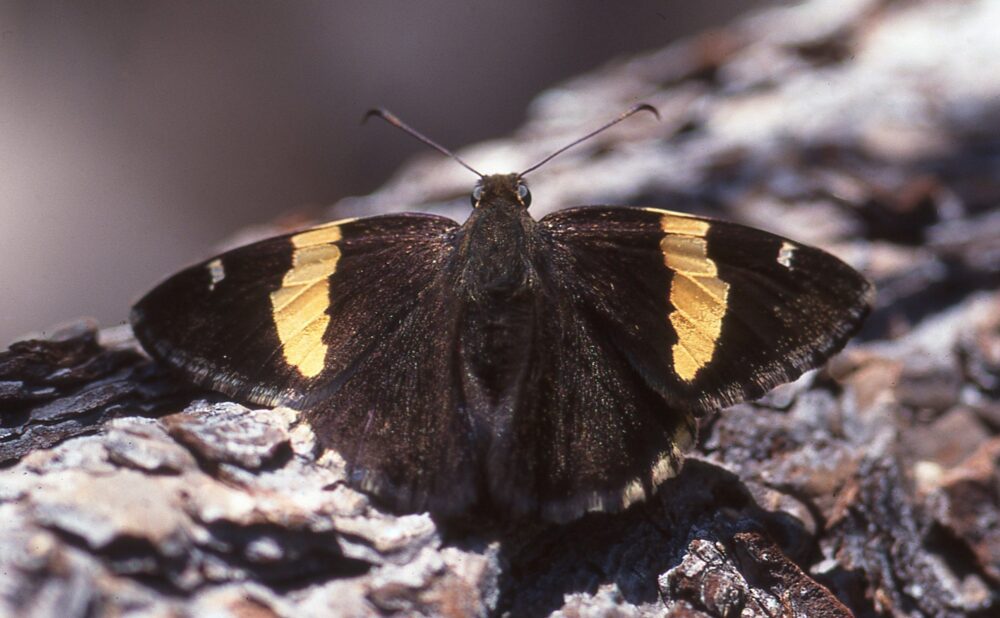
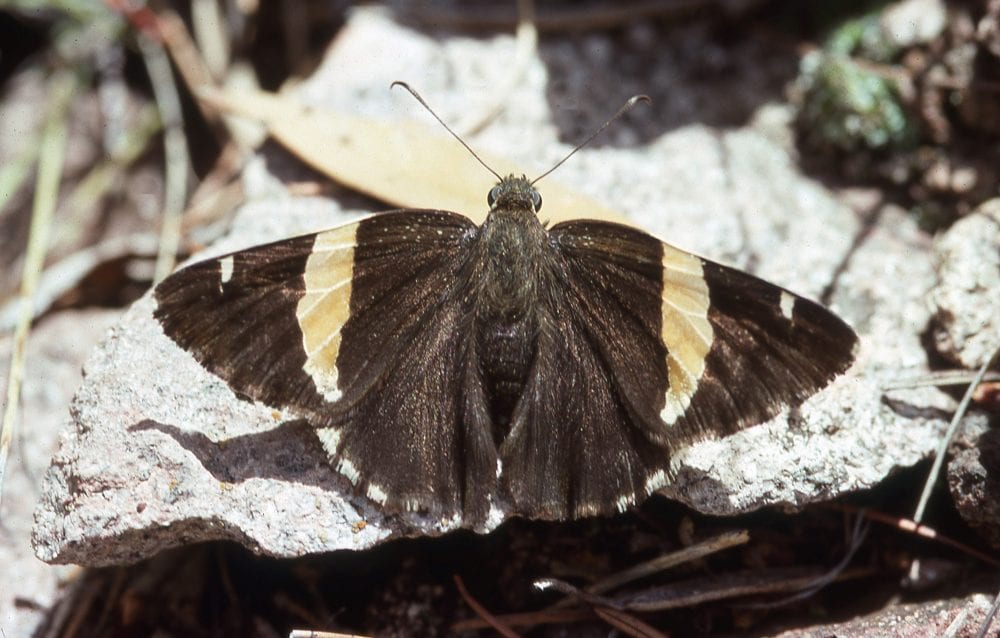

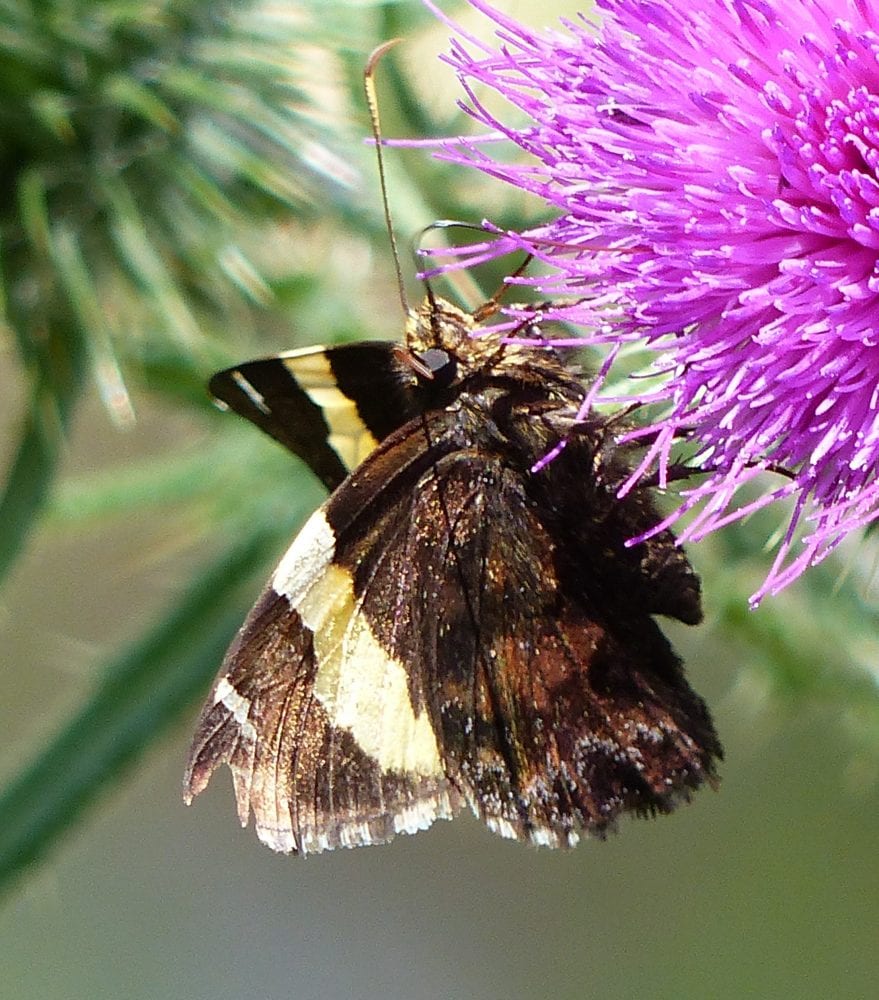
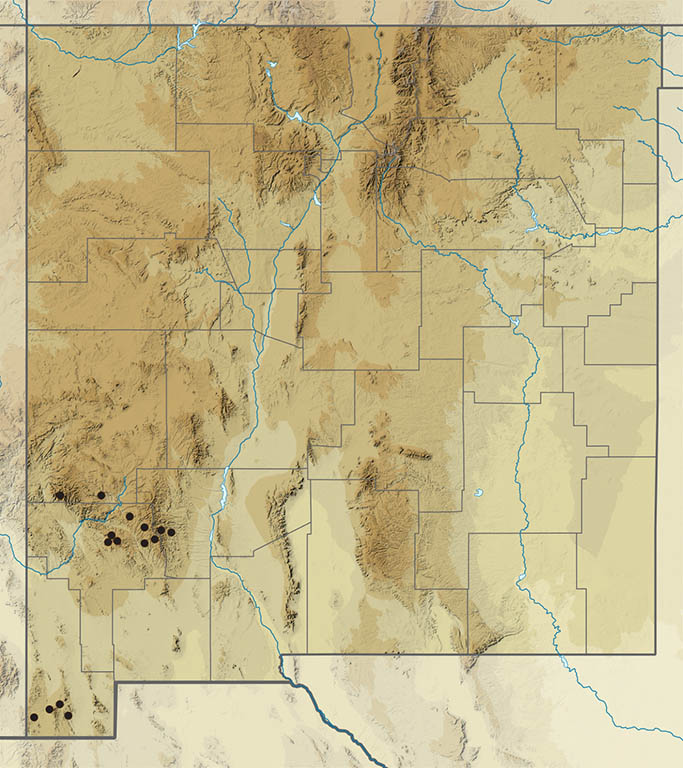
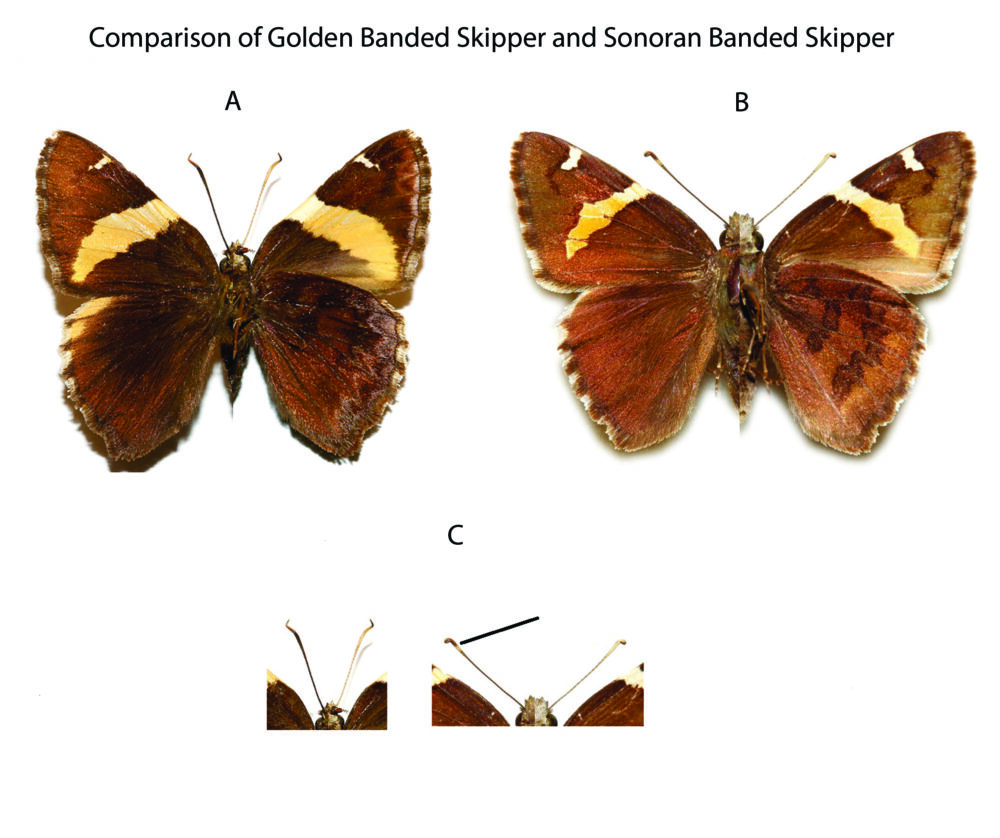
Epargyreus clarus (Cramer 1775) Silver-Spotted Skipper (updated November 4, 2024)
Description. Large for a skipper, Silver-spotted Skippers, including the next species, may be our most recognizable skippers. The hindwing underside sports a bright silver-white blob. The forewing shows a bold gold band above and a bold yellow band below. Range and Habitat. Epargyreus clarus occupies most of the US, shunning only arid areas. It is a routine species in our northern mountains, preferring Transition and Canadian Zone canyons, 6500 to 9200′ elevation (counties: Be,Co,LA,Mo,RA,Sv,SM,SF,Ta,To,Un). Life History. Larvae eat leaves of woody legumes (Fabaceae). A principal host in our area is New Mexico locust (Robinia neomexicana), a native shrub or small tree which colonizes disturbed areas. Others may include Robinia pseudoacacia and Glyccirhyza lepidota in the Rockies (Scott 1992). Flight. Males perch on protruding branches from which they defend territories in riparian corridors. Peak flight is in June, but records span April 19 to August 20, suggesting one extended or two overlapping broods each summer. Then in 2024, one was photographed on October 23 by Rene Laubach. Adults nectar at beebalm (Monarda) and thistle (Cirsium). Pupae overwinter. Comments. Individuals from southern New Mexico belong to the next species, Epargyreus huachuca Dixon. Andy Warren suggests that “The final word on [old] clarus will be determined by a careful study of what is going on within 100 miles of Albuquerque.” Until that happens, we include here the Epargyreus populations in the Sandia (Be) and Manzano Mountains (To,Va).
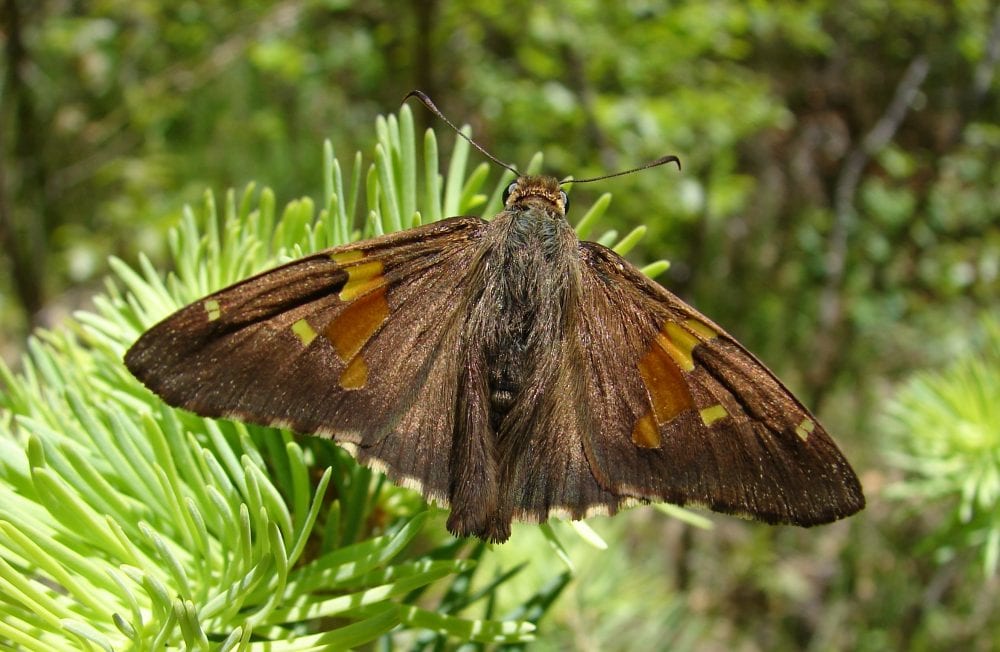

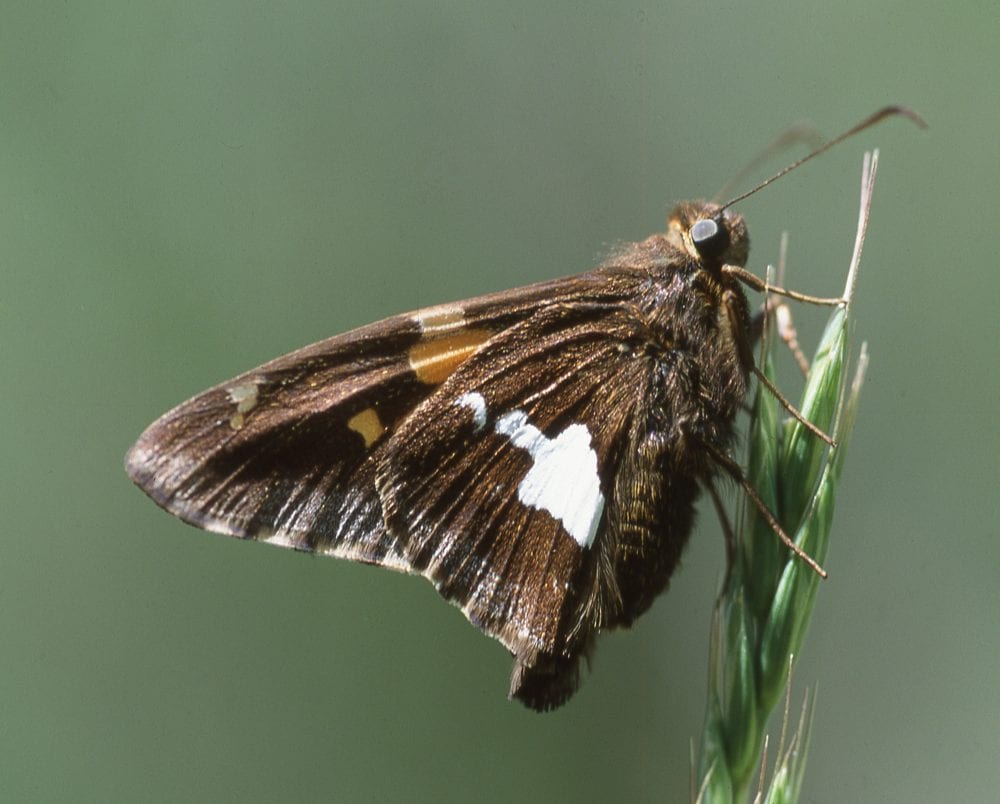
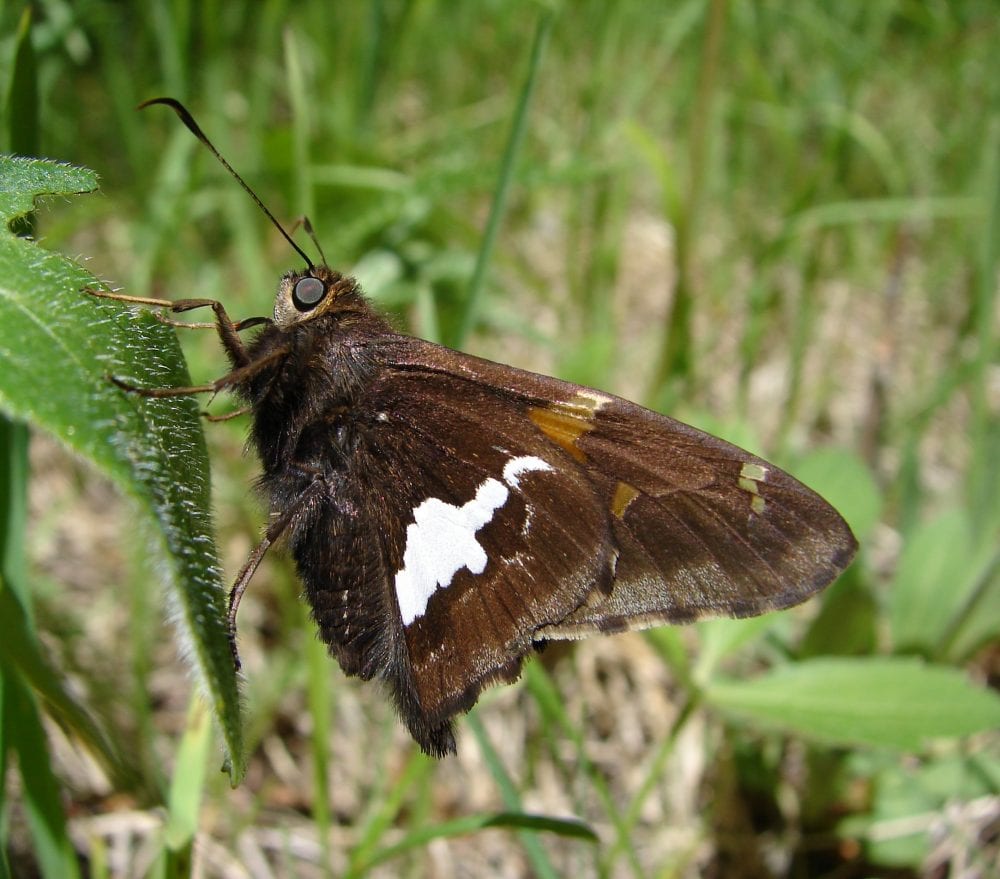
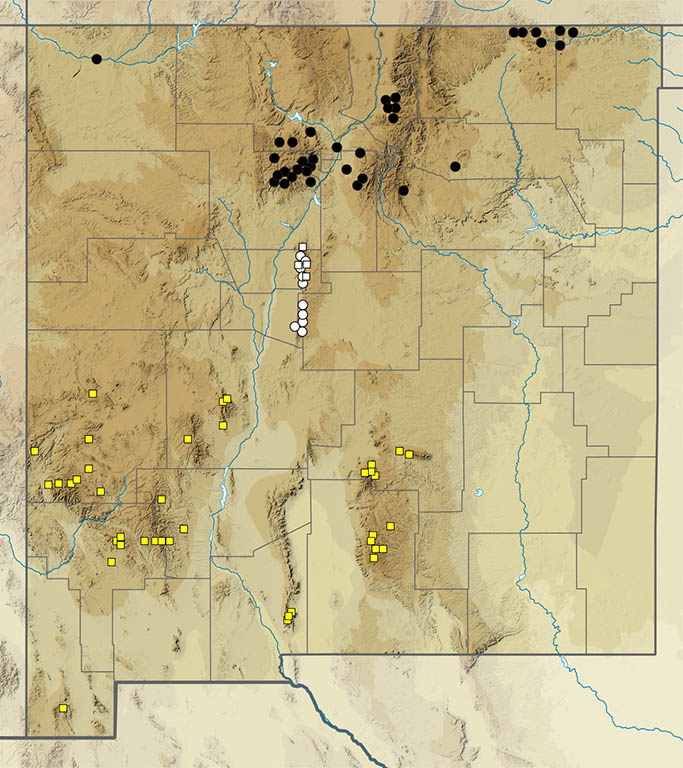
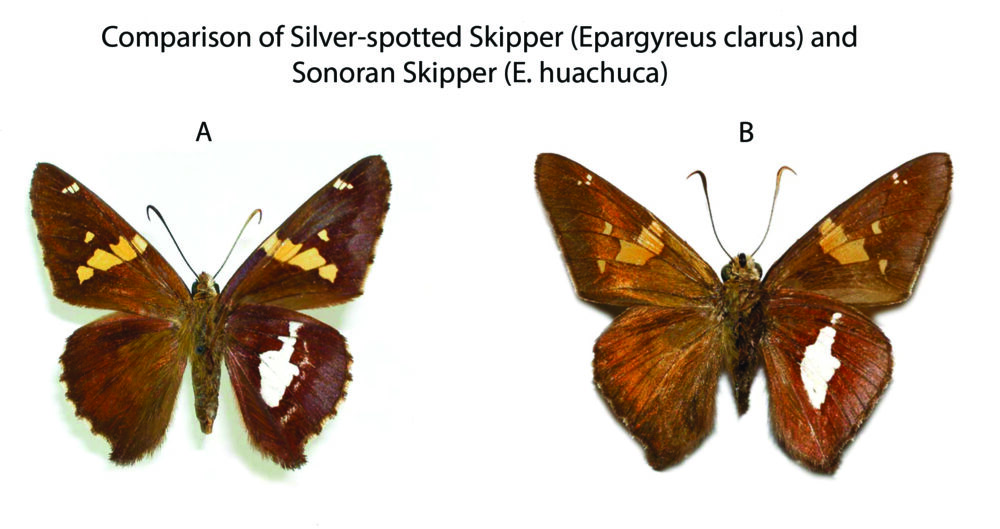
Epargyreus huachuca (Dixon 1955) Huachuca Skipper (updated May 28, 2023)
Description. Huachuca Skipper is the spitting image of Silver-spotted Skipper, with minor differences. In particular, the posterior spot of the forewing gold/yellow band is displaced toward the wing margin, leaving it separated from the rest of the gold/yellow band. Range and Habitat. While Epargyreus clarus occupies most of non-arid eastern and northern U.S., Epargyreus huachuca replaces it in the Sky Islands of the southwestern US. Huachuca Skipper is fairly routine in southern New Mexico’s montane woodlands where it prefers Transition and Canadian Zone canyons with hostplants, 7500 to 9500′ elevation (counties: Ca,DA,Gr,Hi,Li,Ot,Si,So). Life History. Larvae eat leaves of woody legumes (Fabaceae). The principal host in our area appears to be New Mexico locust (Robinia neomexicana), but Robinia pseudoacacia and Glyccirhyza lepidota also may be used. Flight. Males patrol and defend territories in riparian corridors. Peak flight is in June, but records are known from April 29 to August 22, suggesting one very extended or two overlapping broods each summer. Adults nectar at flowers and balance electrolytes at damp soil. Pupae overwinter. Comments. Zhang et al. (2020) pulled huachuca out from under clarus. Toliver et al. (2000) commented that clarus and huachuca are not well differentiated in NM. Very recently, Andy Warren (pers. comm., October 2021) suggested that populations within 100 miles of Albuquerque, when studied, may have a lot to say about the final arrangement of these two visually similar creatures. Until that happens, we include populations in Lincoln and Otero counties under E. huachuca. This species is sometimes called Sonoran Skipper, causing potential confusion with the other Sonoran Skipper: Polites sonora.
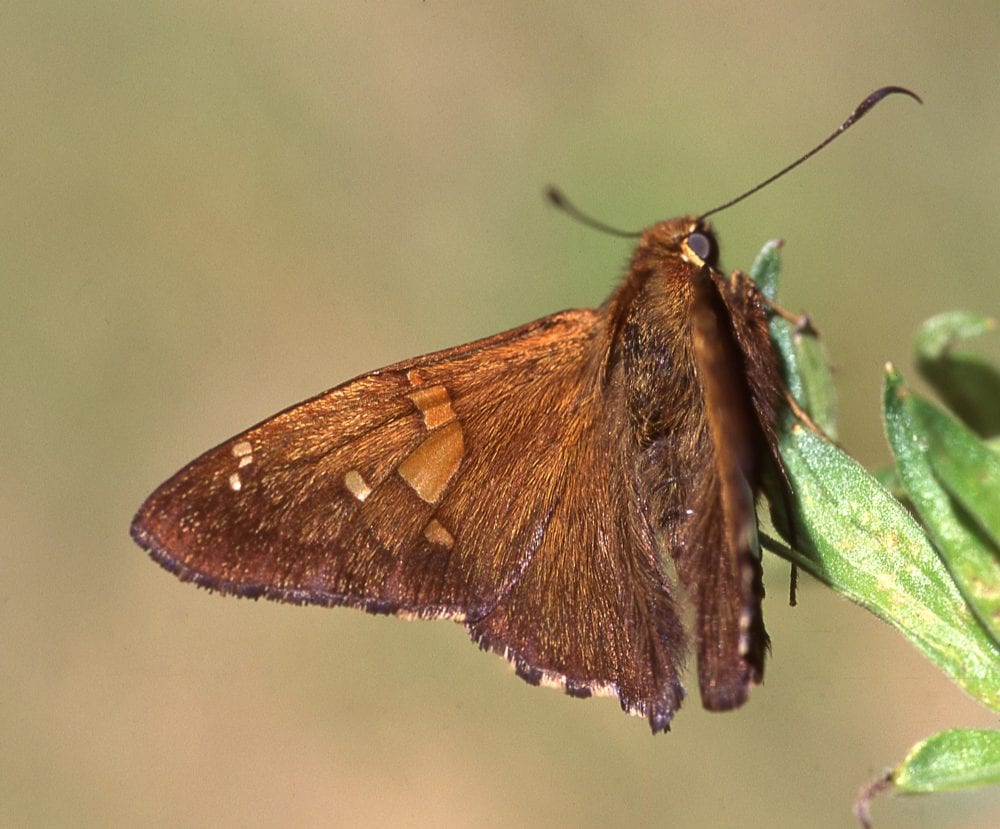
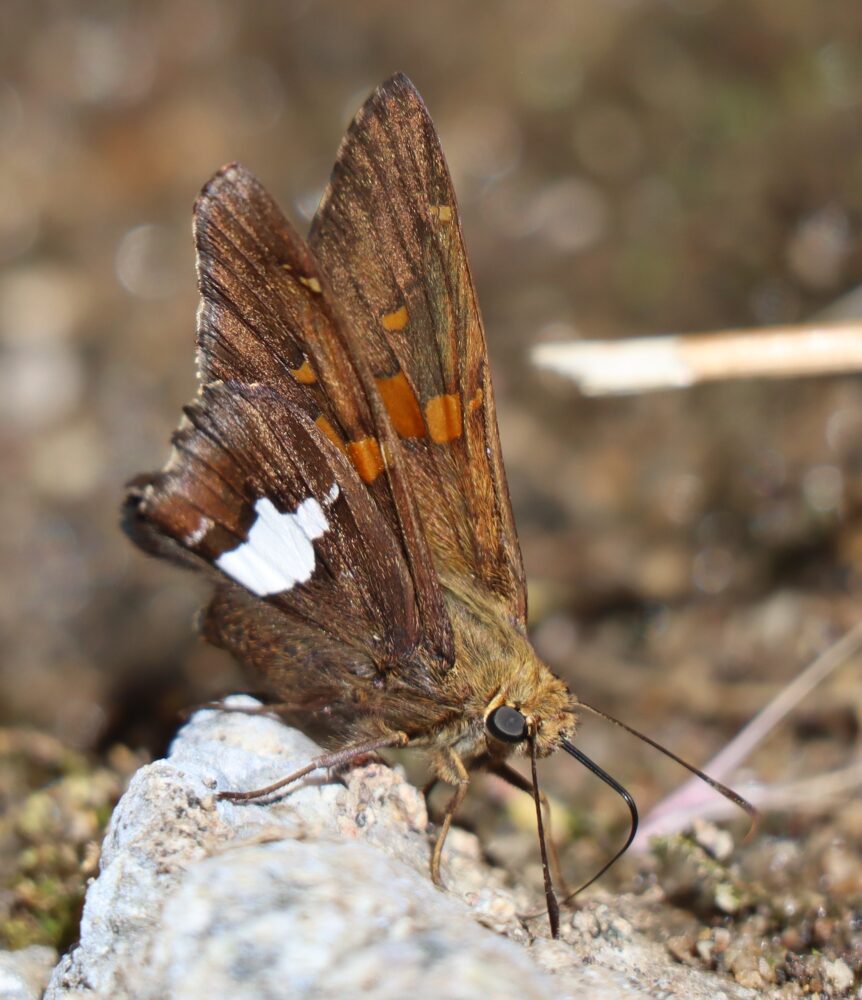
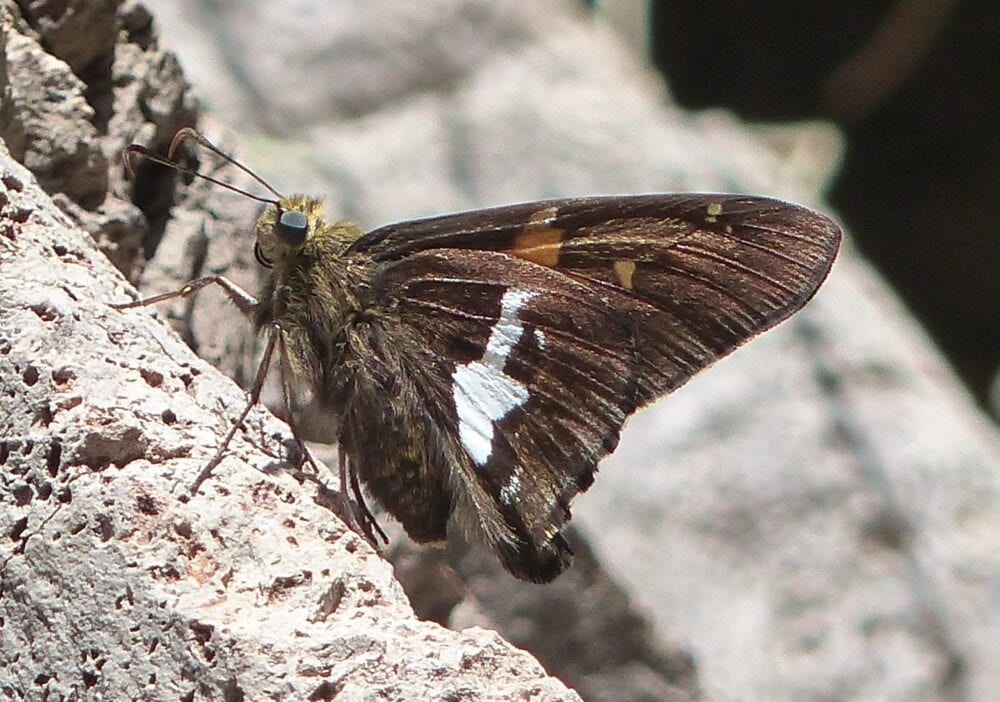
Chioides albofasciatus (Hewitson 1867) White-Striped Longtail (updated August 15, 2022)
Description. White-Striped Longtail is distinguished by – can you guess? – a bold white stripe and a tail as long as the rest of the hindwing. The DFW spot pattern resembles that of the Southern Cloudywing, but even in an individual White-Striped Longtail which had lost its tails, the bold white stripe on the VHW would immediately distinguish it from other known NM Eudaminae. The Gold-spotted Aguna (Aguna asander [Hewitson, 1867]), which may eventually be found in NM, has a somewhat similar white stripe, but the shape of the stripe is different, it lacks tails, and the FW spots are orange-red rather than cream. Range and habitat. This beauty lives in South America, Mexico and the Caribbean islands. Individuals occasionally stray into southern Arizona, southern Texas and southern New Mexico (counties: Hi,Lu), where it is a very memorable find. In addition to the records from NM, the species has been found in west TX close to the SE NM border (El Paso and the Davis Mtns.). Life history. Legumes (Fabaceae) are larval hosts in the breeding range. Galactia wrightii (Fabaceae) was shown to be a host in southeast Arizona (J. Brock, pers. com.). Flight. Males patrol stream corridors looking for mates while nectaring at seepwillow (Baccharis spp.). Our few New Mexico records fall between August 1 and October 30, during and after the monsoon season. Comments. Until recently (see Opler and Warren 2002), Chioides albofasciatus was considered to be a subspecies of Chioides catillus (Cramer 1779).
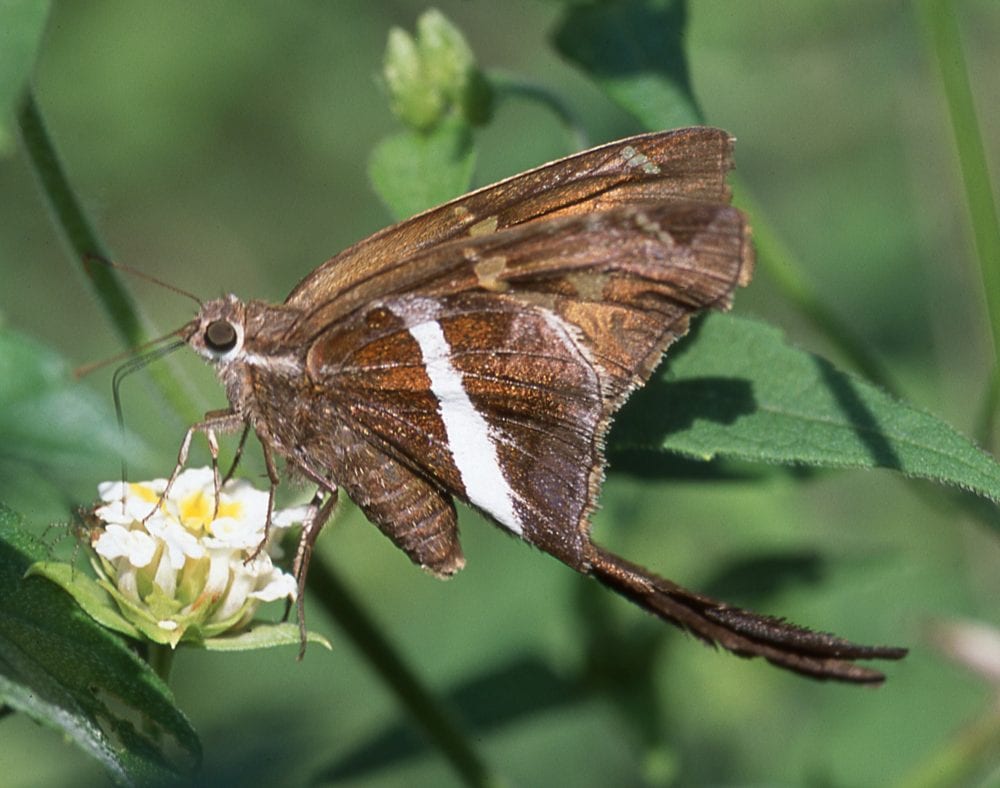
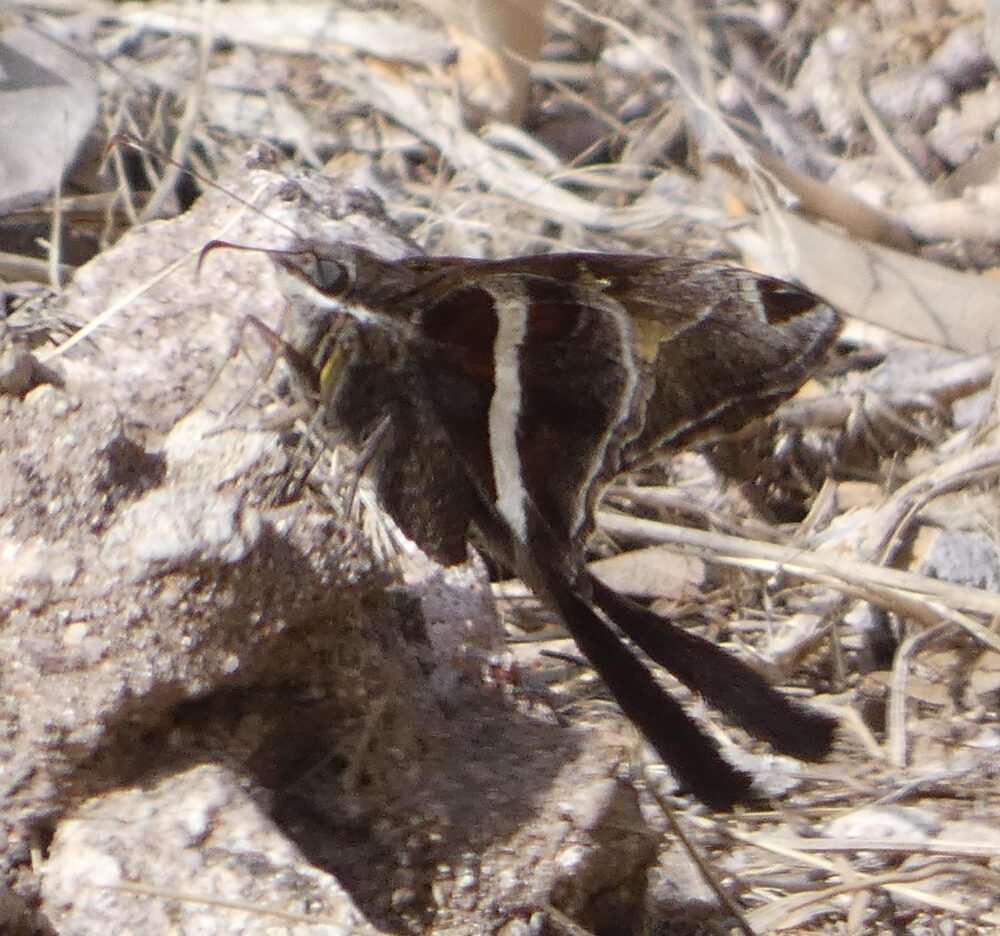
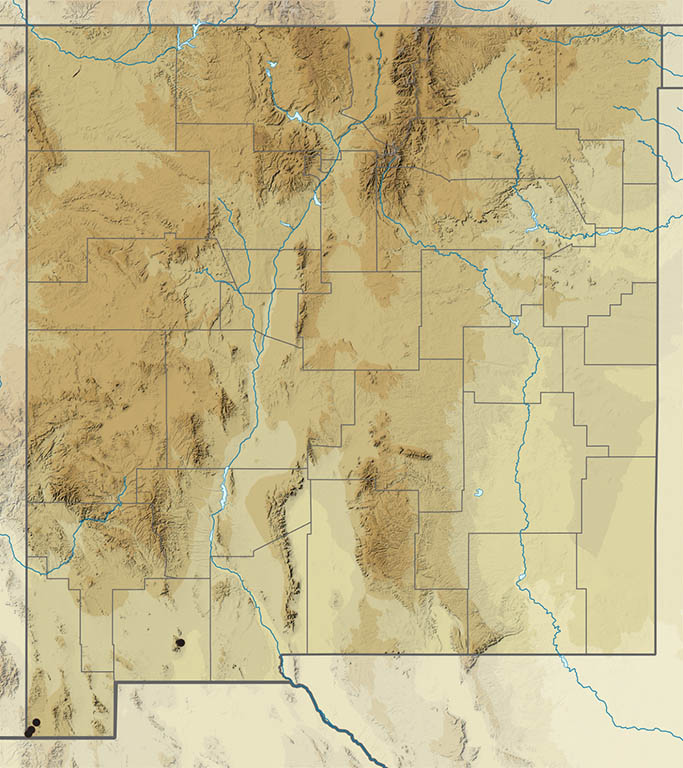
Chioides zilpa (Butler 1872) Zilpa Longtail (updated August 15, 2022)
Description. Much like White-Striped Longtail in size and shape, Zilpa has a unique pattern of olive and tan with patches of white and brown on the hindwing underneath. Also note the dark triangle near the ventral forewing apex. Range and Habitat. This skipper lives from Ecuador north to Mexico and into south Texas. It rarely strays to southern Arizona, southern New Mexico and even as far as Kansas. Life History. Larvae eat leguminous vines (Fabaceae), but reproduction is unlikely in New Mexico. Flight. Zilpa is least improbable here during the late summer monsoons. Comments. Our single record was videotaped on 26 August 2001 at Percha Dam State Park (Si) by Christopher Rustay, Douglas Emkalns and Bruce Neville.
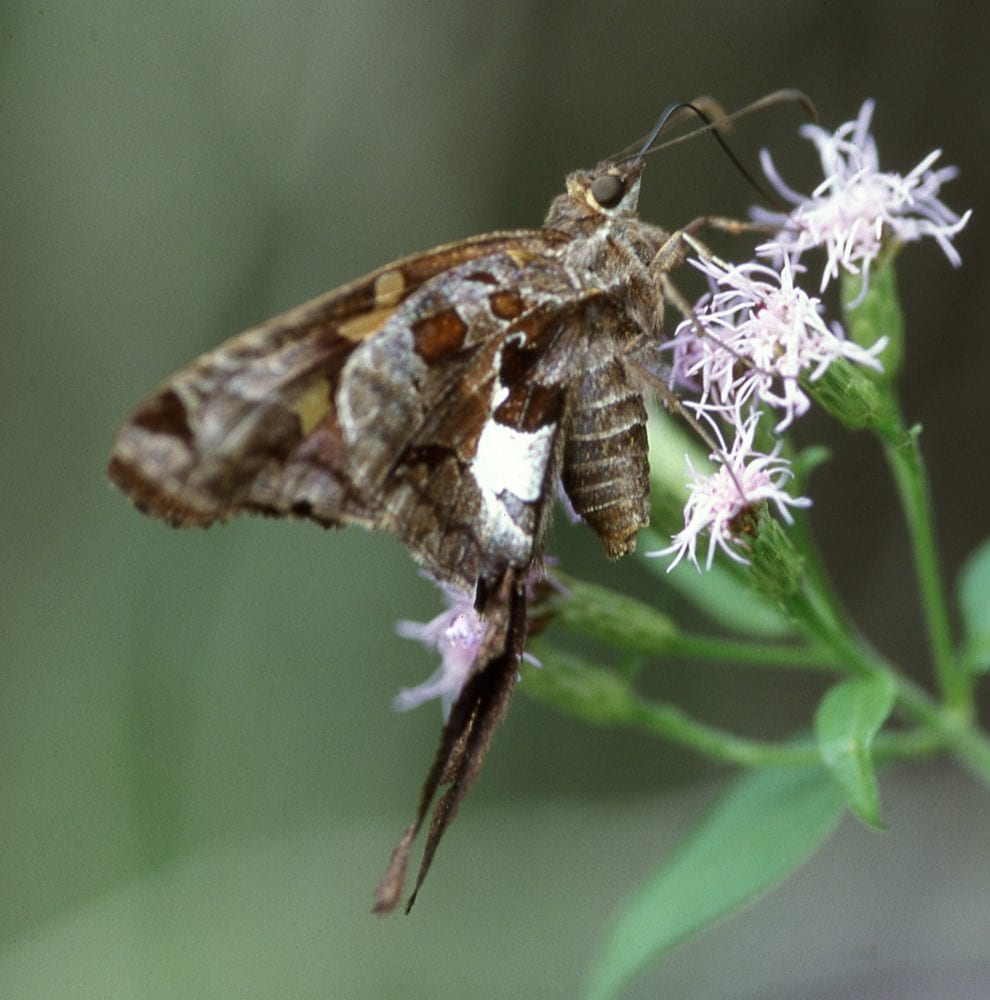
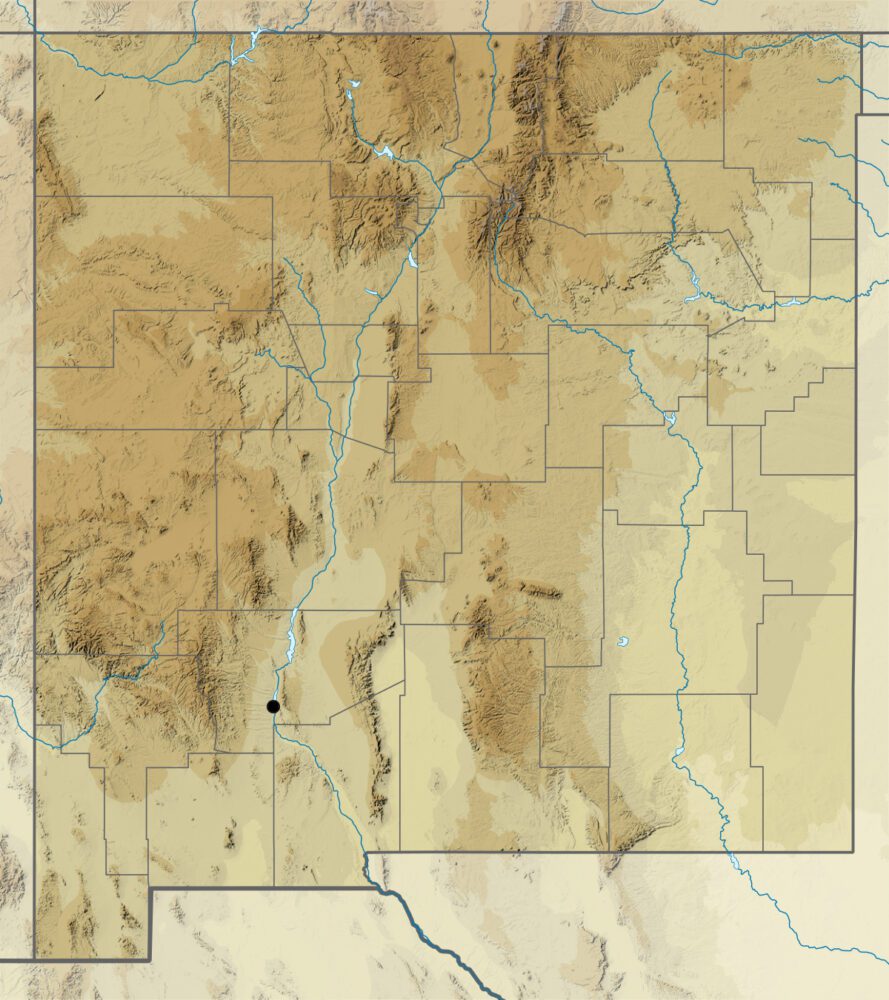
Codatractus arizonensis (Skinner 1905) Arizona Skipper (updated August 16, 2022)
Description. About the same bulky size as Epargyreus clarus and E. huachuca, the Arizona Skipper has a prominent, hoary whitish patch along the margin of the hindwing below. The DFW spots are cream, rather than orange-gold as in Epargyreus. Range and Habitat. The distribution of this Mexican species reaches northward into southwest Texas, southern Arizona, and southwest New Mexico (counties: Hi,Lu). Life History. Bailowitz and Brock (2022) reported Eysenhardtia orthocarpa (Fabaceae) as a food plant in southeast Arizona, so it breeds seasonally there. There are two or more broods every year in its breeding range to the south. The recent photo (below) of a gravid female in southern Hidalgo County is evidence that it reproduces here, or least places eggs here, too. Flight. Males defend territories in Upper Sonoran Zone riparian corridors and arroyos. Except for a single report for late April, suggesting a sparse local spring flight, our remaining New Mexico sightings fall between July 30 and August 10. Comments. Codatractus arizonensisis is one of the many attractive, if infrequent, subtropical strays that tantalize butterfly chasers in our Bootheel riparian areas during the monsoon season.
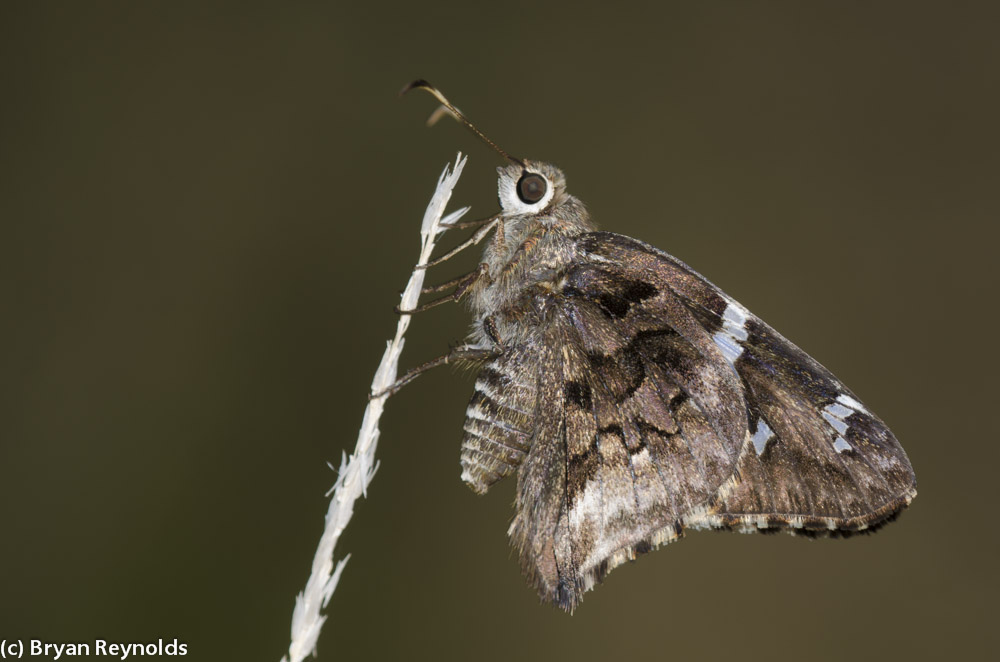
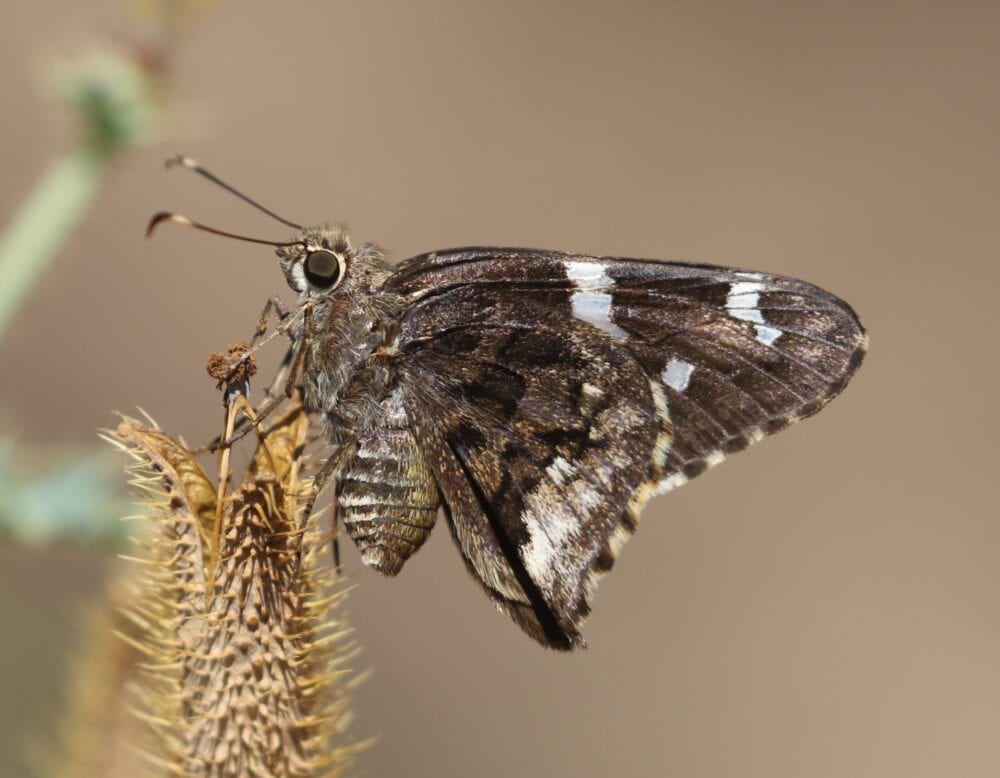
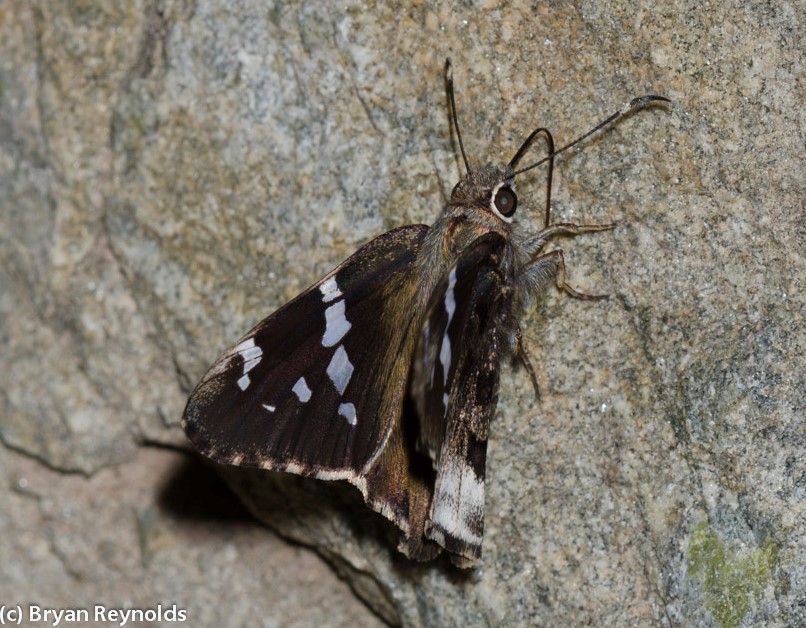
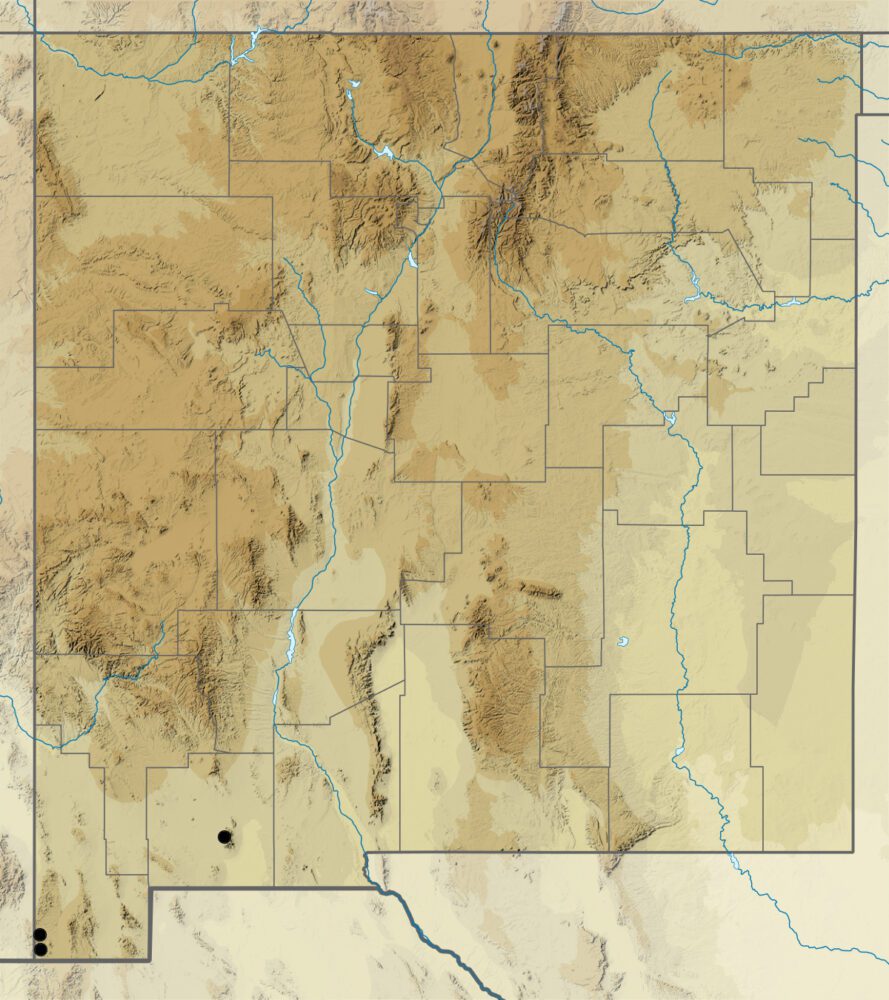
Zestusa dorus (W. H. Edwards 1882) Short-tailed Skipper (updated May 7, 2025)
Description. For Short-tailed Skipper, the cluster of three white post-median spots on the hindwing above is a diagnostic feature. Also note the pronounced lobe at back of the hindwing, where some species have pronounced tails. A uniquely intricate ventral pattern is accented by pale blue tints. Range and Habitat. Zestusa dorus occurs from the Sierra Madre of Mexico north into Arizona, New Mexico and southernmost Colorado. It is a denizen of scruffy, oak-covered hillsides and canyons in habitats ranging from Upper Sonoran to Transition Zones (counties: Be,Ca,Co,Gr,Hi,Li,LA,Lu?MK?,Mo,Ot,RA,Sv,SJ,SM,SF,Si,So,Ta,To,Un,Va) generally 6200 to 8500′ elevation. Life History. Oaks (Fagaceae) serve as larval hosts for this butterfly. Quercus arizonica and Quercus emoryi are confirmed. Quercus gambelii, Quercus grisea and Quercus undulata are inferred to be hosts based on adult association. Winter is passed as pupae, then adults emerge with the first warm spring weather. Flight. This insect is widespread, but not often seen, perhaps because of its early flight. Look for it between March 22 and May 31: mostly April in southern New Mexico and a month later farther north. Adults feed at moist earth and tree sap; evidence of nectar feeding is scant (e.g., Prunus spp.). Males perch on twigs and branches of oaks when they are still in bud. Comments. A scarce summer generation is reported in southeast Arizona (Bailowitz and Brock 1991), but as yet there is no evidence of this in New Mexico. Female Zestusa dorus are rarely encountered in nature.
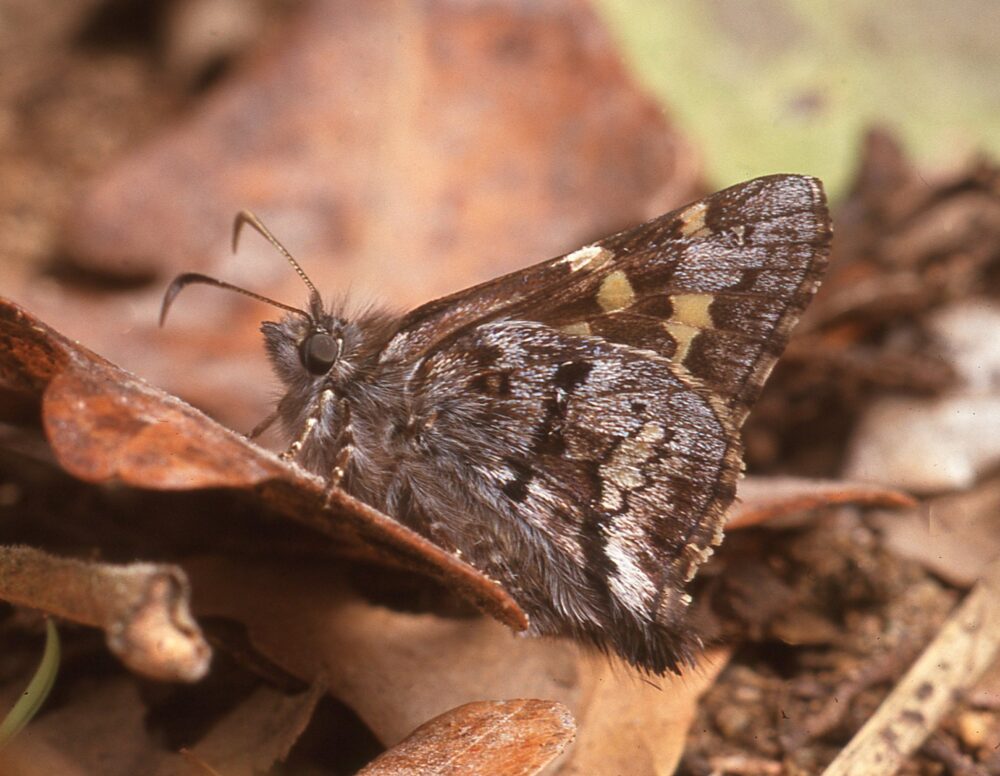
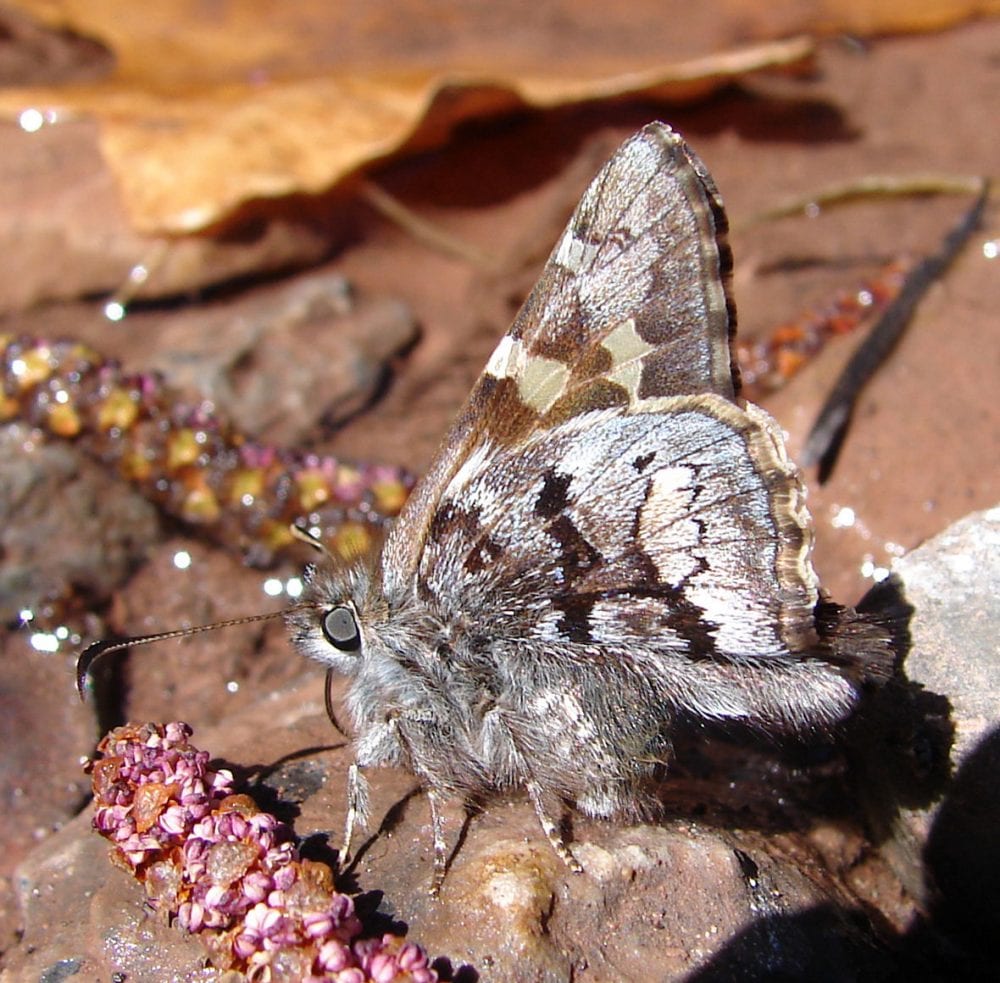
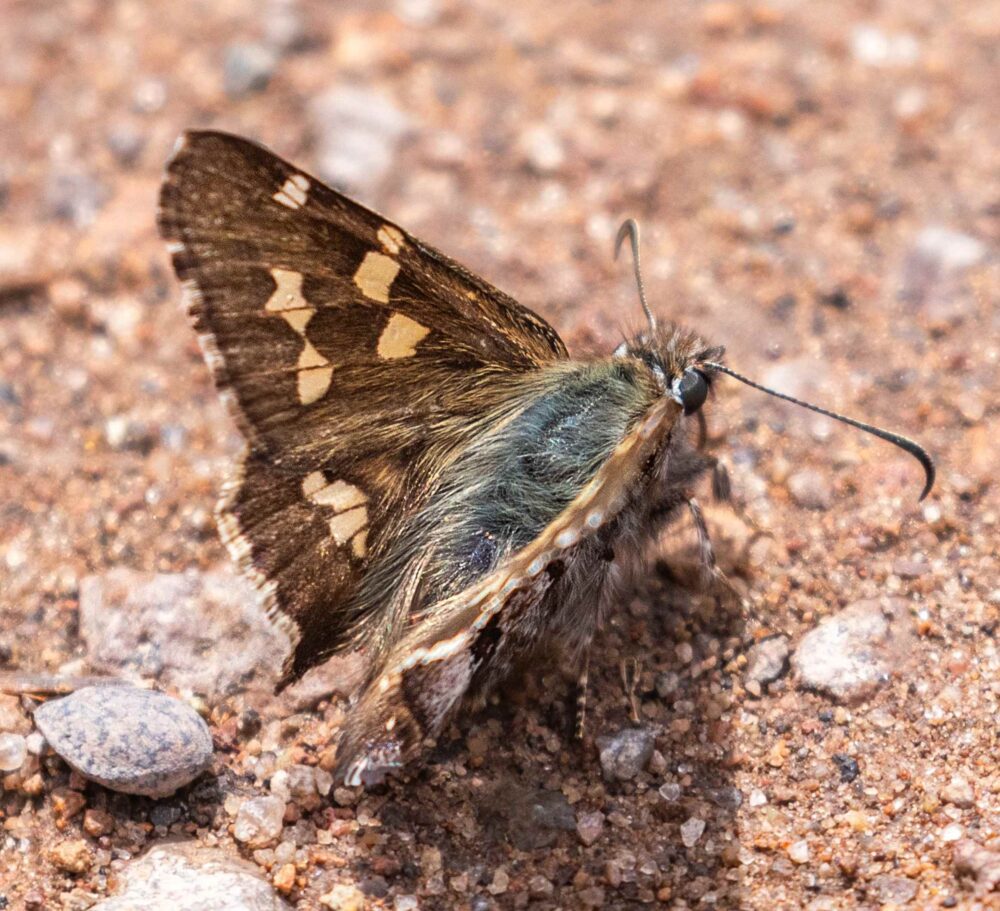
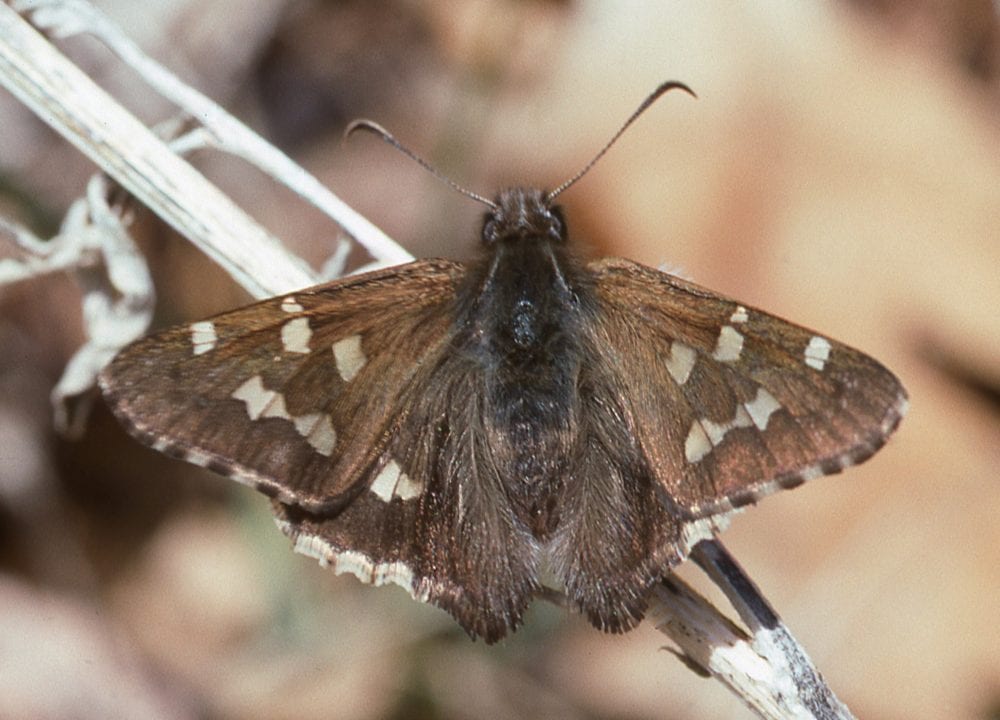
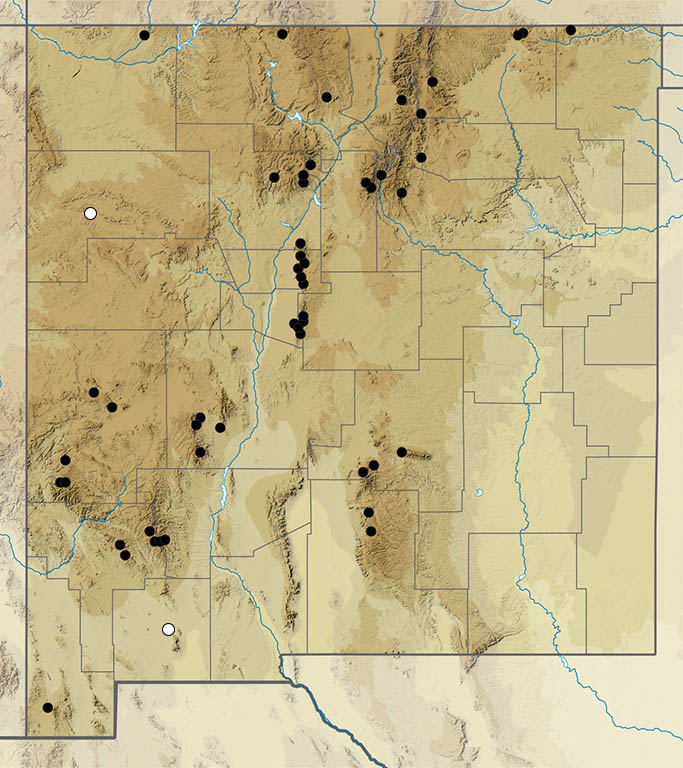
Polygonus arizonensis (Skinner 1911) North American Polygon (updated November 30, 2023)
Description. This big skipper has a characteristic pattern of white spots on the forewing above, a violet tinge to the hindwing below, and a prominent lobe at the back of the hindwing. Range and Habitat. North American Polygons (what a great name!) occasionally wander from Mexico into New Mexico, where they loiter in riparian areas with nectar and water along our southern border (counties: Ca,Ed,Hi,Ot,Si,To). Life History. Legumes (Fabaceae) are likely hosts in Mexico, where this species breeds. This Polygon can have two or more broods per year. Flight. Late summer vagrants to New Mexico have been seen from July 31 to November 2. Comments. Formerly Polygonus leo (Gmelin [1790]), Zhang et al. (Feb. 2023) determined that the Mexican populations were sufficiently distinct to warrant species status. Our oldest record is a specimen in the Allyn Museum of Entomology from Willard (To), 2 June 1913. It probably traces to a traveler passing through on the AT&SF Railroad, around which Willard was founded in 1902.
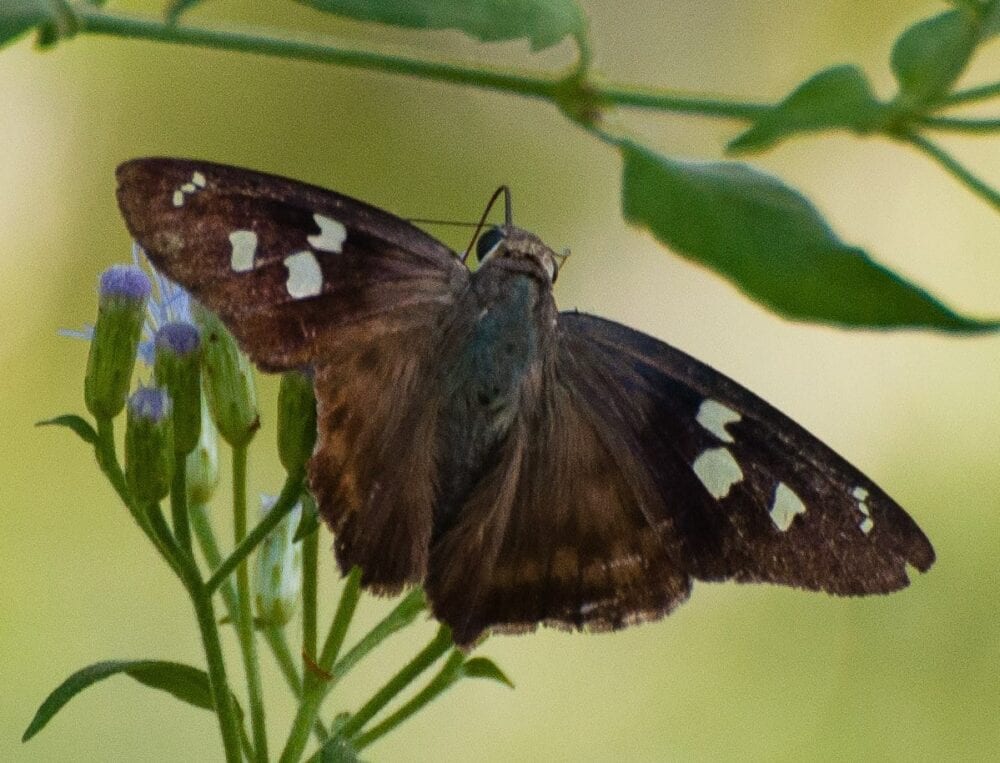
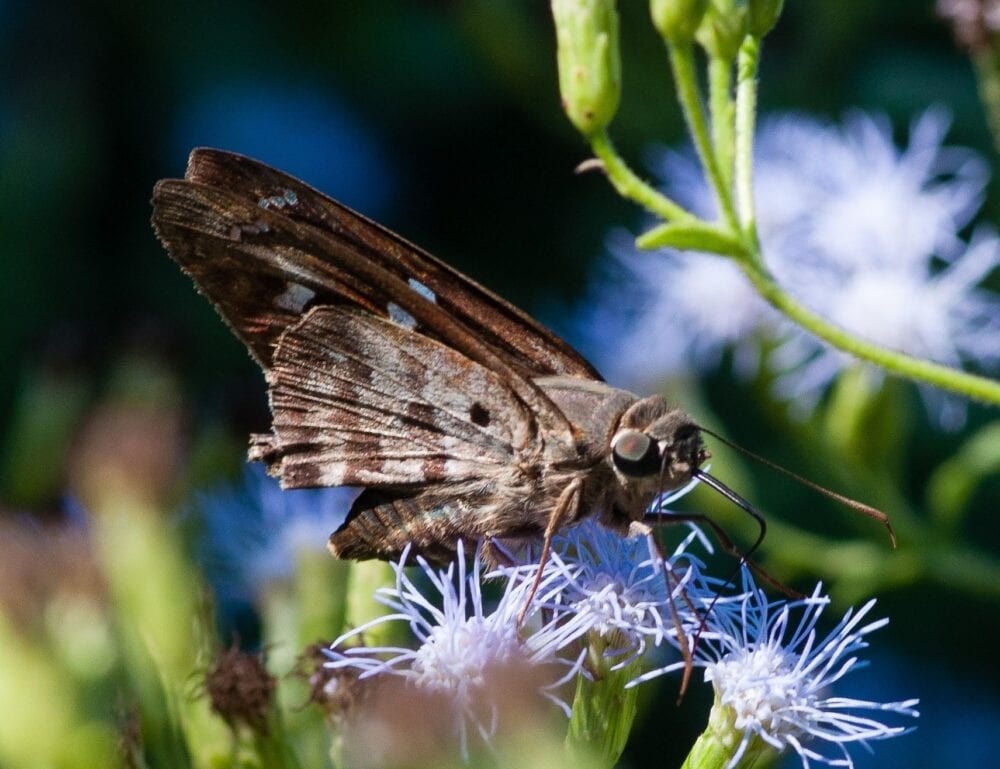
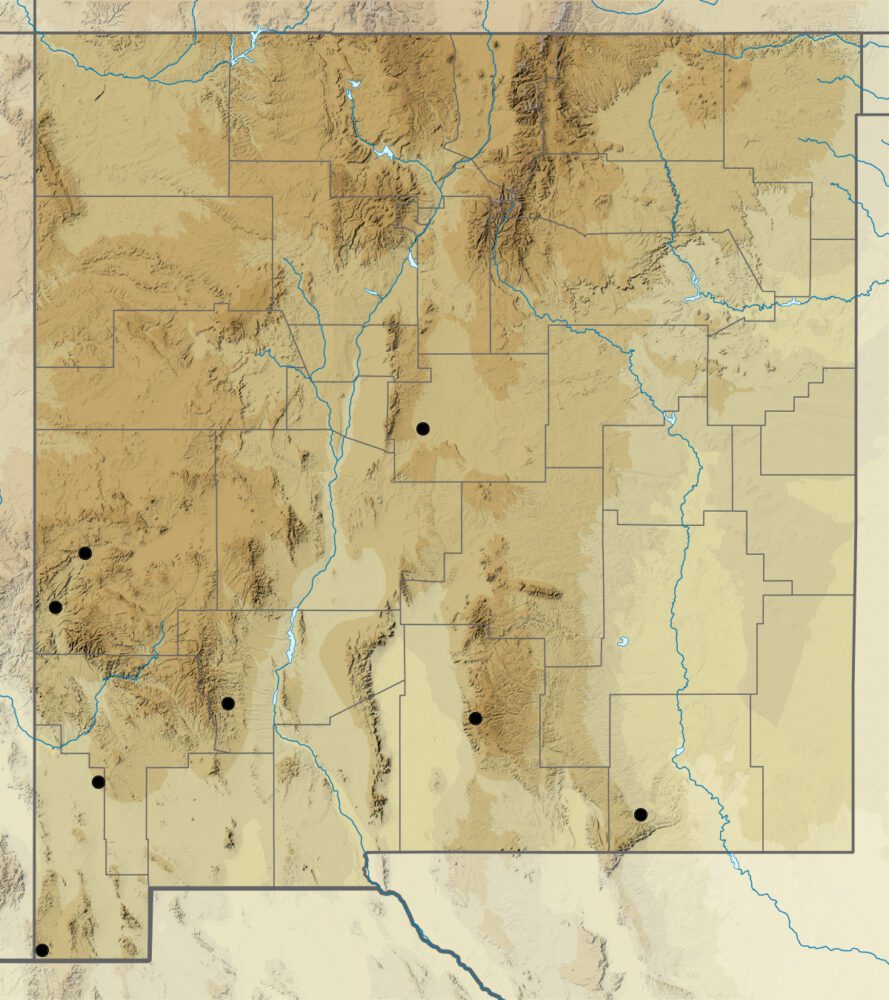
Cogia hippalus (W. H. Edwards 1882) Acacia Skipper (updated February 23, 2024)
Description. Acacia Skippers resemble other medium size, white-edged Eudamiines in southern New Mexico. Distinguish them by larger dorsal forewing white spots, a creamy white hindwing fringe, banded antennal shafts, hindwing shape and ventral hindwing markings. Range and Habitat. This species occurs from South America to Mexico. It barely reaches into the US in southern Arizona, west Texas and southern New Mexico (counties: DA,Ed,Gr,Hi,Lu,Si). In New Mexico it is resident in canyons and drainages in Upper Sonoran Zone grasslands and open scrublands, where the larval host grows. Life History. The only reported larval host for our region is the thorny shrub, Whiteball Acacia (Acacia angustissima; Fabaceae). Flight. Cogia hippalus has two generations in New Mexico; records span April 17 to September 22, with peak flight from July to August. Adults patrol arroyos and canyon bottoms, nectaring and balancing electrolytes at moist earth. Comments. Here at the northern edge of its range, the Acacia Skipper is seen inconsistently, though it does seem to be getting more predictable in some areas. Credit Mike Toliver with the first New Mexico report, from Clanton Draw, Peloncillo Mountains (Hi) on 5 July 1975.
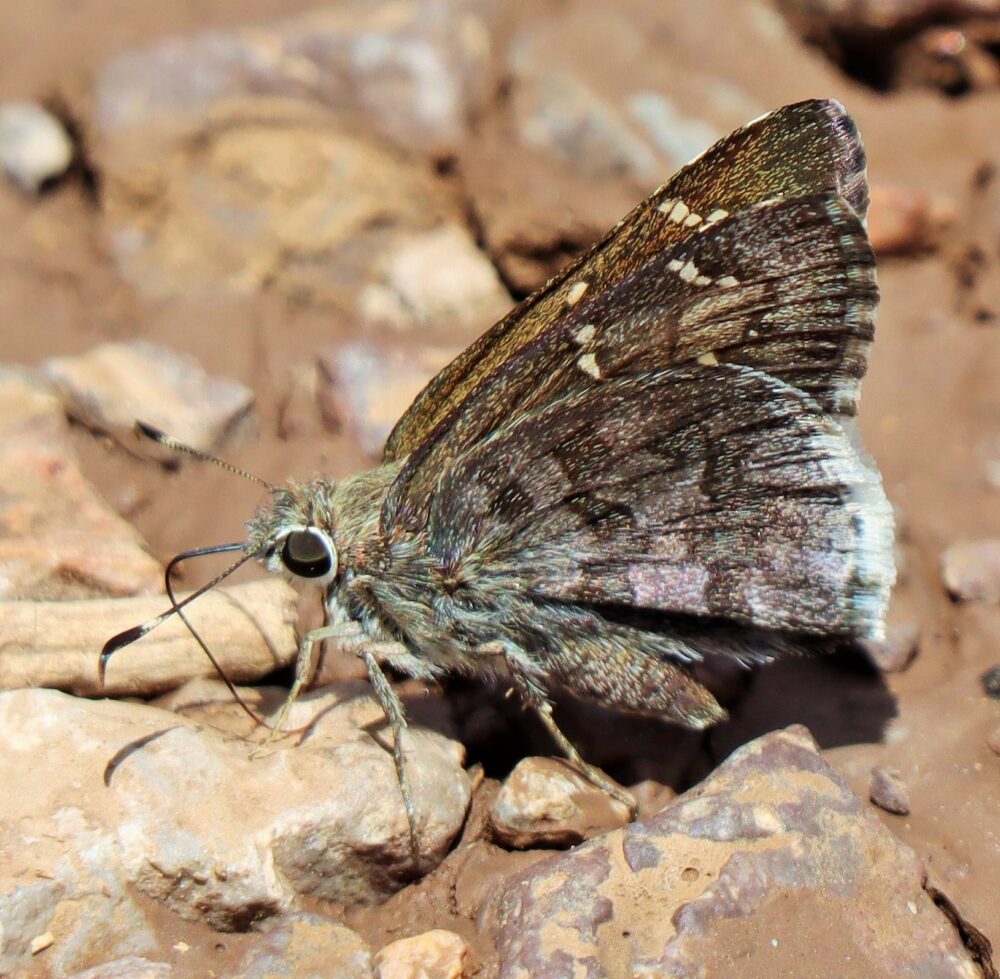
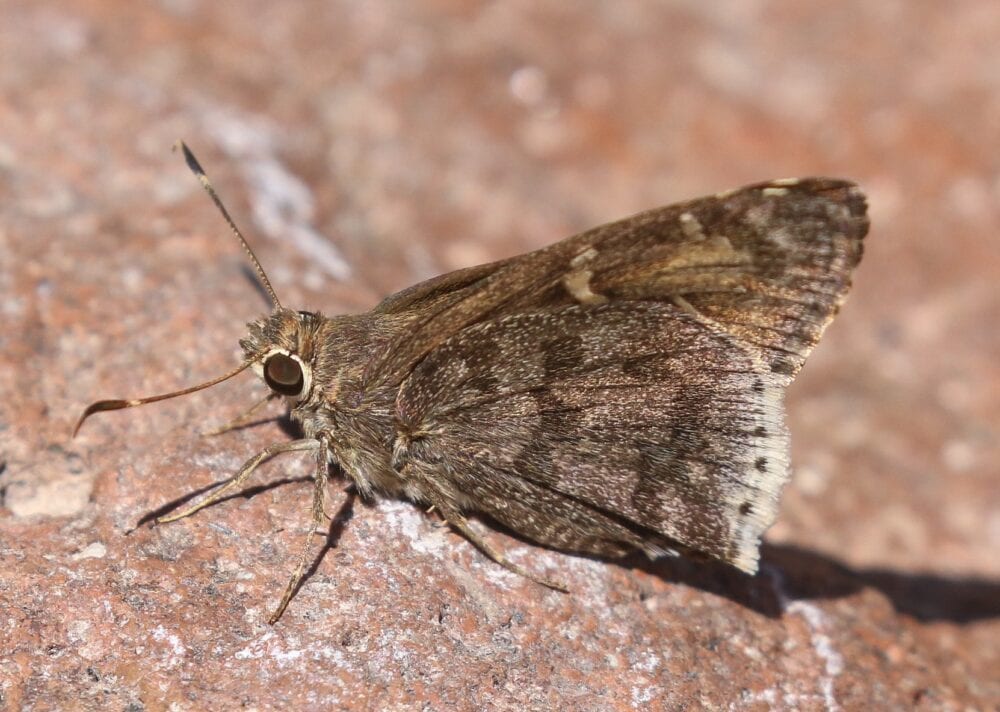
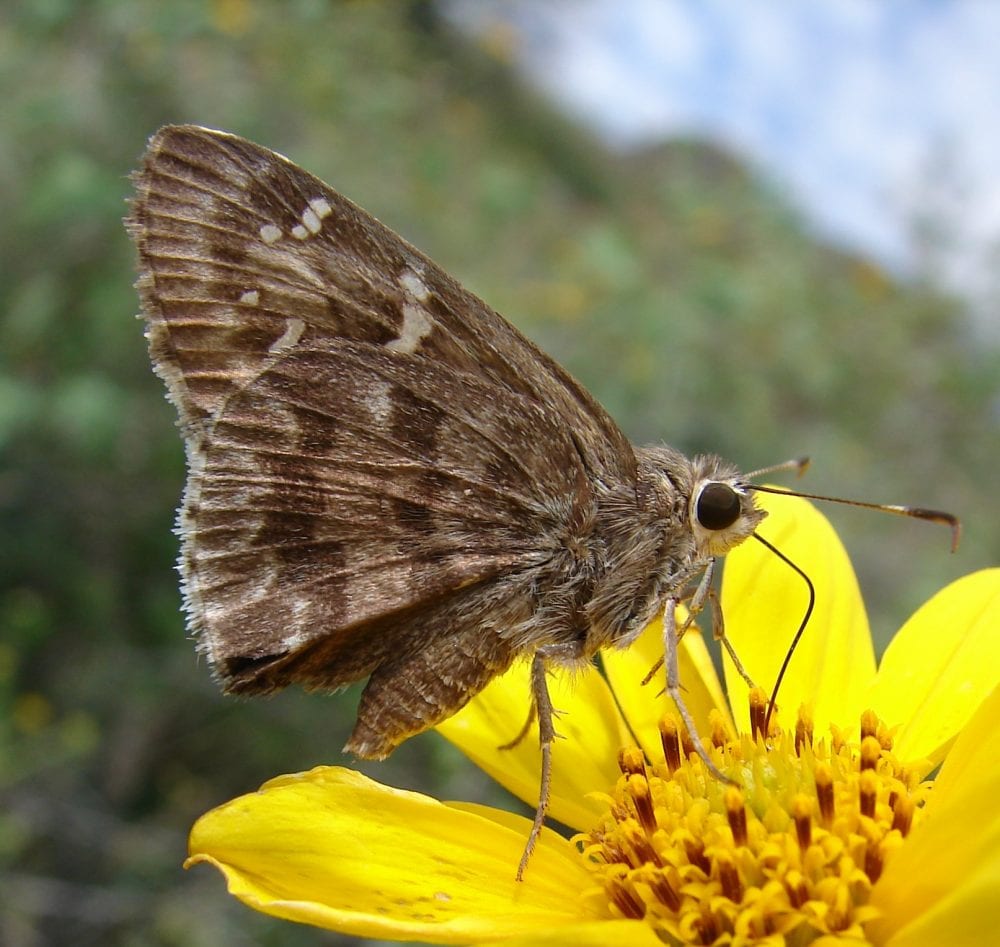
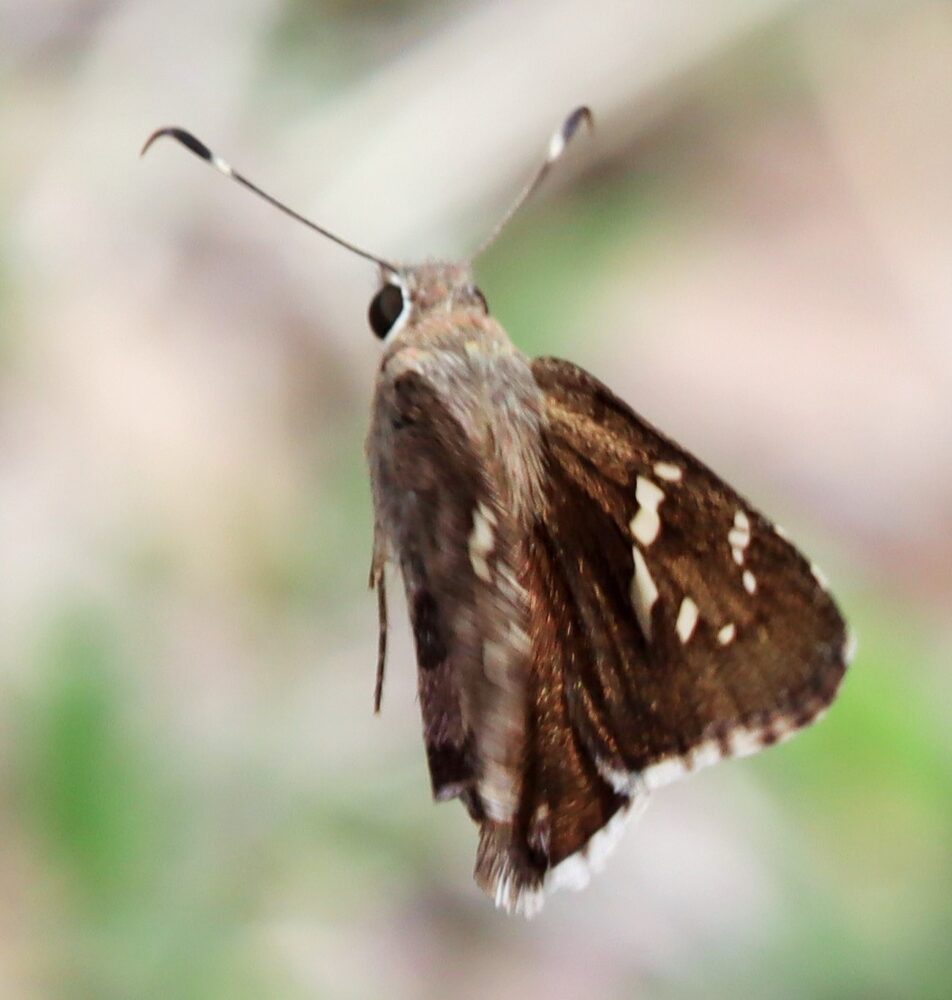
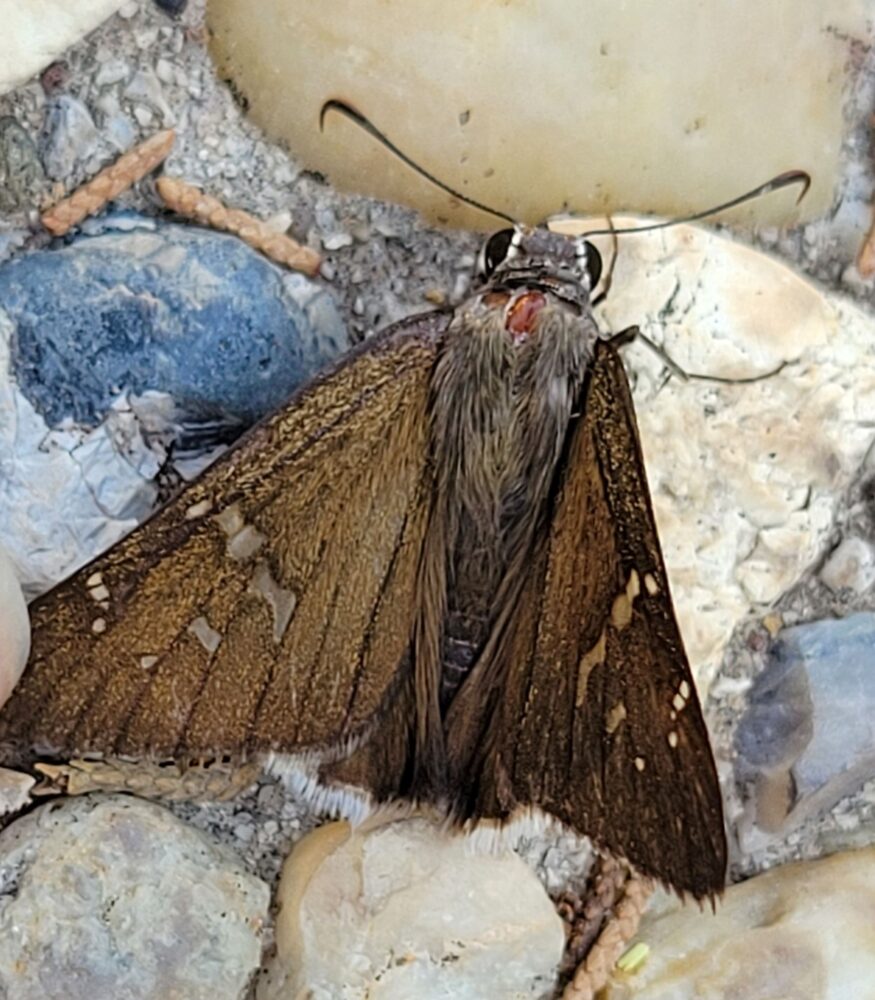
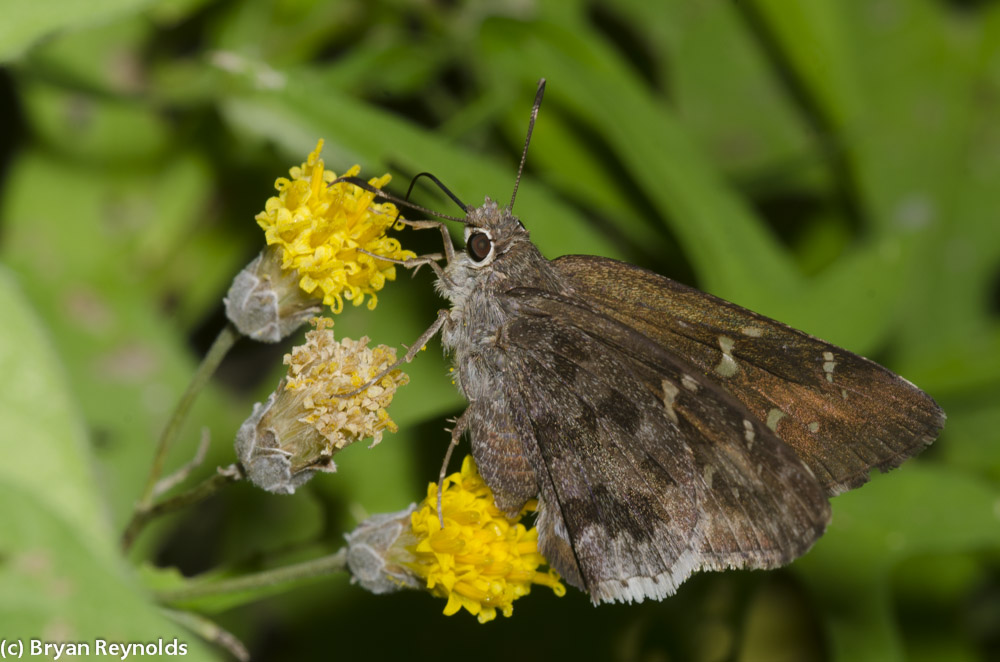
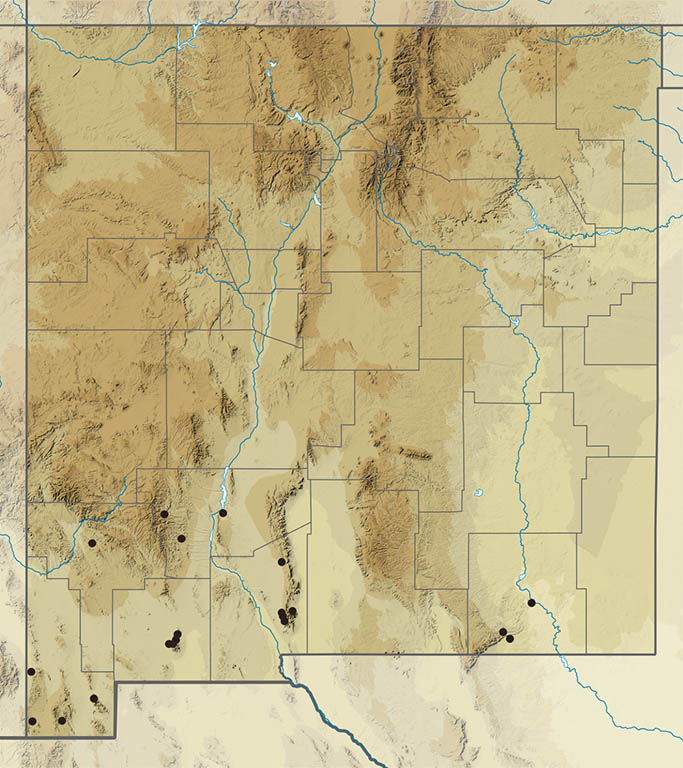
Cogia moschus (W. H. Edwards 1882) Yellow-Costa Skipper (updated November 30, 2023)
Description. Yellow-costa Skipper resembles Acacia Skipper, but is usually smaller, with darker ventral hindwing colors and white scaling near the ventral hindwing margin. The leading edge of the forewing is yellow, which sounds obvious, but it is pencil-thin and you really have to be looking for it. Range and Habitat. This species is somewhat regular in our southwest quadrant (counties: Ca,Ed?,Gr,Hi,Lu,Si). Look for it in foothill canyons of desert mountains, from 5000 to 6700′. It ranges south to Central America. Life History. Whiteball acacia (Acacia angustissima, Fabaceae) is a reported larval hostplant in southeast Arizona. Flight. In New Mexico there are two generations per year. The spring generation flies from about April 8 to May 25; the summer brood flies from about July 19 to September 6. Males establish and defend territories by perching on rocks in canyon bottoms, then patrolling up- and down-canyon. “It shows a decided predilection for large rocks in either dry or wet streambeds, where its low, exceptionally bouncy flight readily identifies it” (Zimmerman 2001). Adults often nectar at thistles. Comments. Zhang et al. Oct. 2023 demonstrated that our populations are not merely a subspecies of the Mexican species, Gold-costa Skipper (Cogia caicus [Herrich-Schäffer 1869], but a full species in its own right.
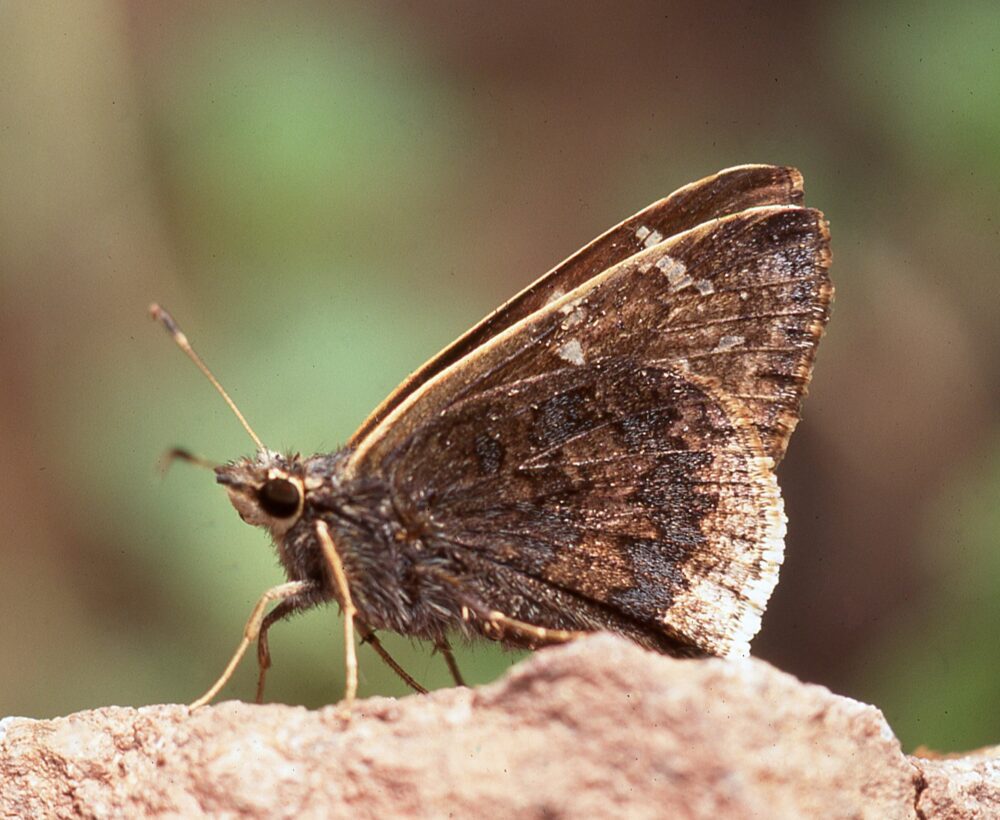
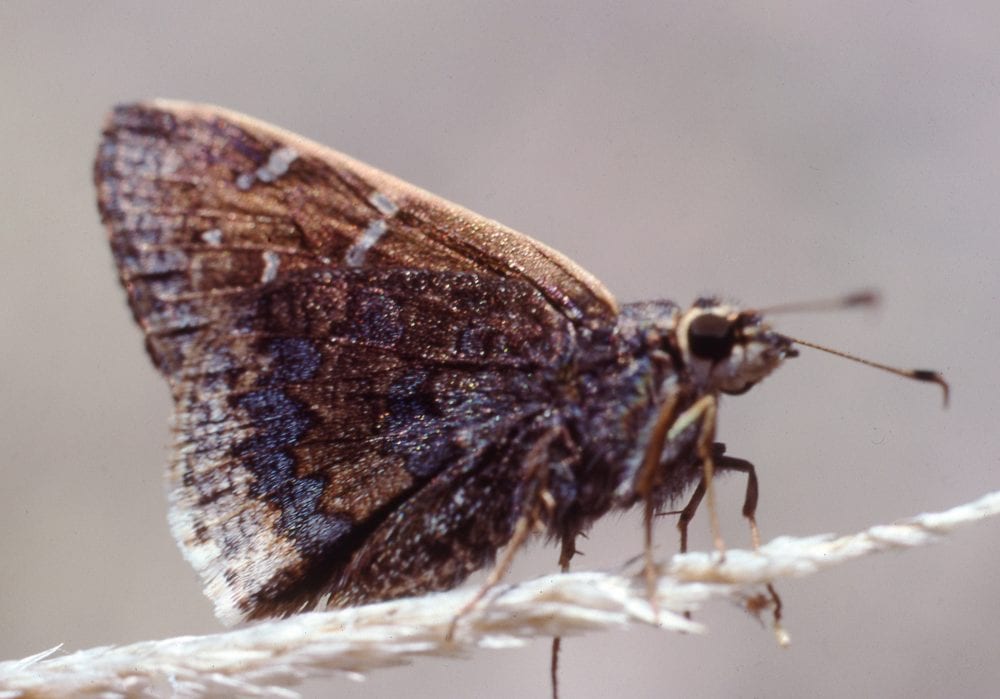
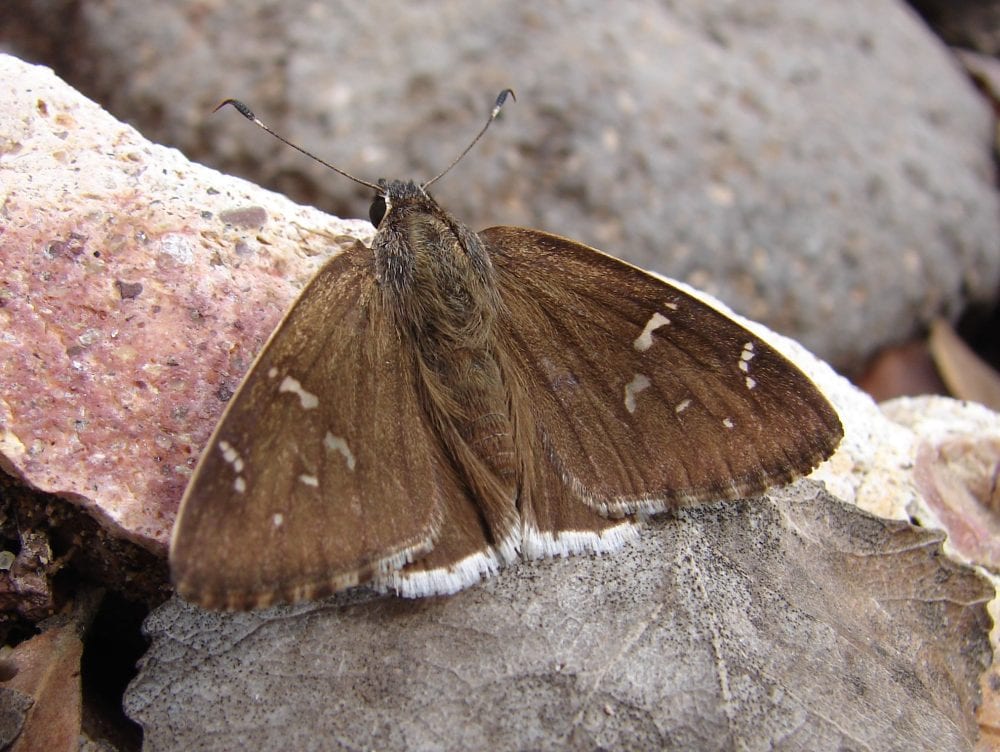
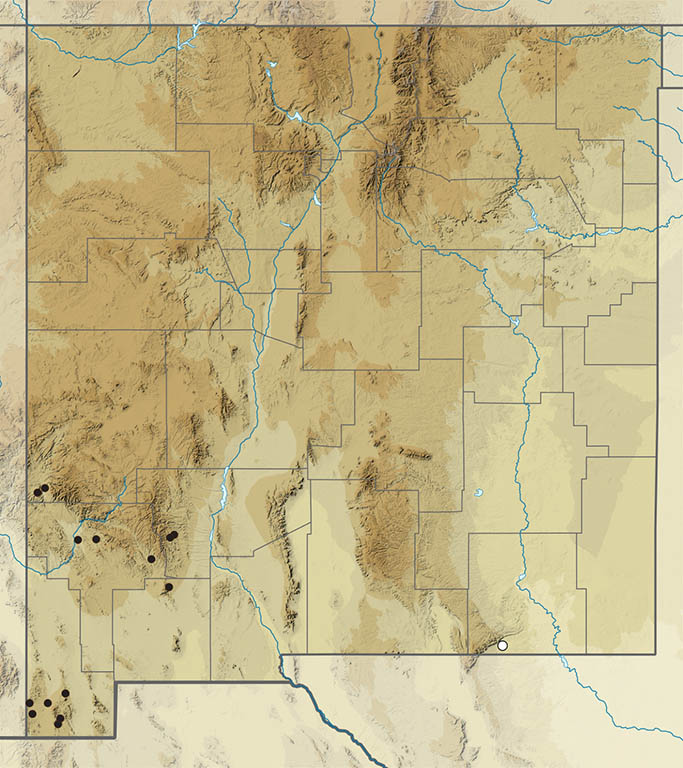
Cogia outis (Skinner 1894) Outis Skipper (added February 26, 2024)
Description. Outis Skippers resemble other medium size, brown-edged Eudamines in New Mexico, particularly Cloudywings (Cecropterus spp.). Distinguish them by larger dorsal forewing white spots with a prominent one at the end of the forewing cell, a light brown, usually uncheckered, hindwing fringe lacking black spots (Cogia hippalus has black spots in the white fringe), a white ring at the base of the antennal club, hindwing shape and ventral hindwing markings. Range and Habitat. This species is currently unrecorded from New Mexico, but a recent discovery in far western Oklahoma (https://www.inaturalist.org/observations/170769553) about 10 miles from our border argues for its inevitable discovery here. Its known range centers on Texas, from there extending south into northeastern Mexico and north into Oklahoma, Missouri and Arkansas. Life History. Larvae feed on Acacia, including Whiteball Acacia (Acacia angustissima; Fabaceae). Flight. Cogia outis has up to four generations per year in its native range. We suspect one or two for New Mexico populations when they are found. Adults are avid flower feeders. The Oklahoma observation shows an individual feeding on Morning Glory in early July. Comments. As noted above, Outis Skipper has yet to be found in New Mexico. Look for it on our Eastern Plains from spring into summer.
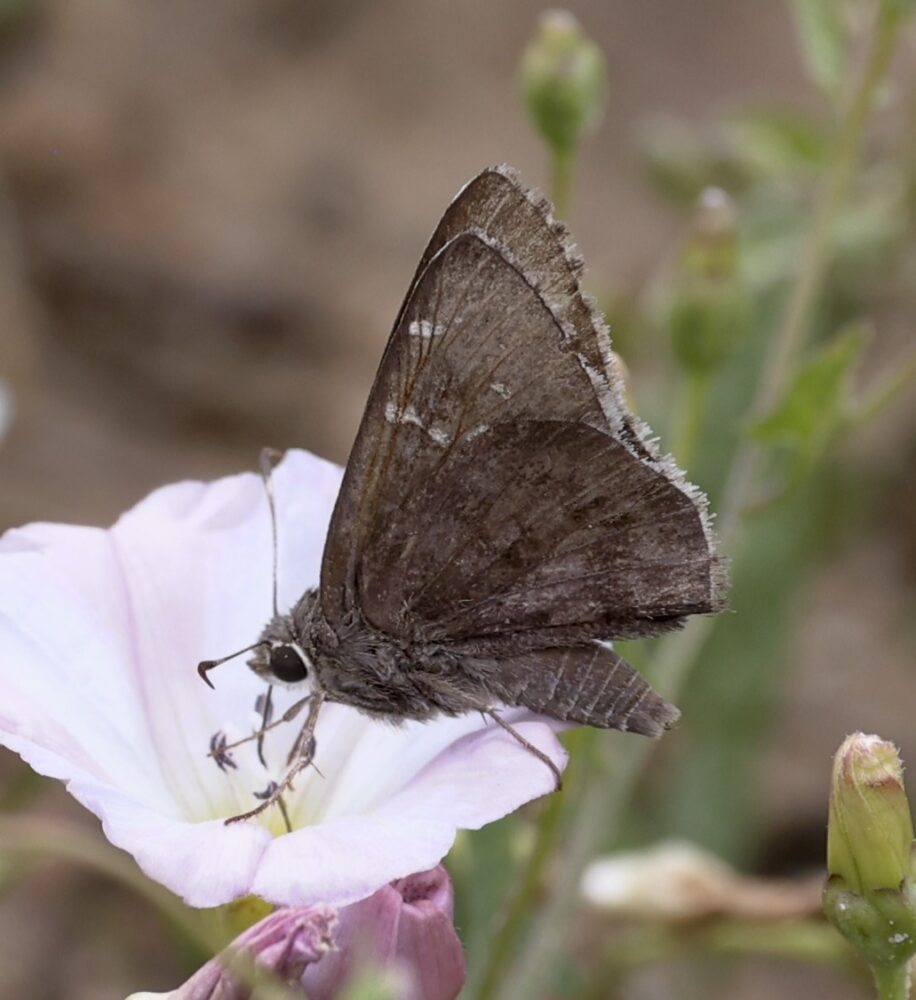
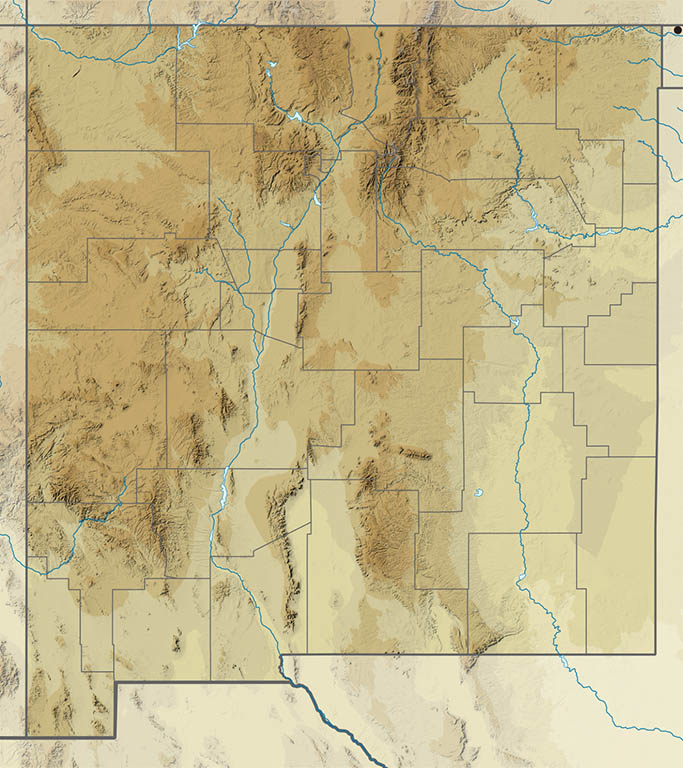
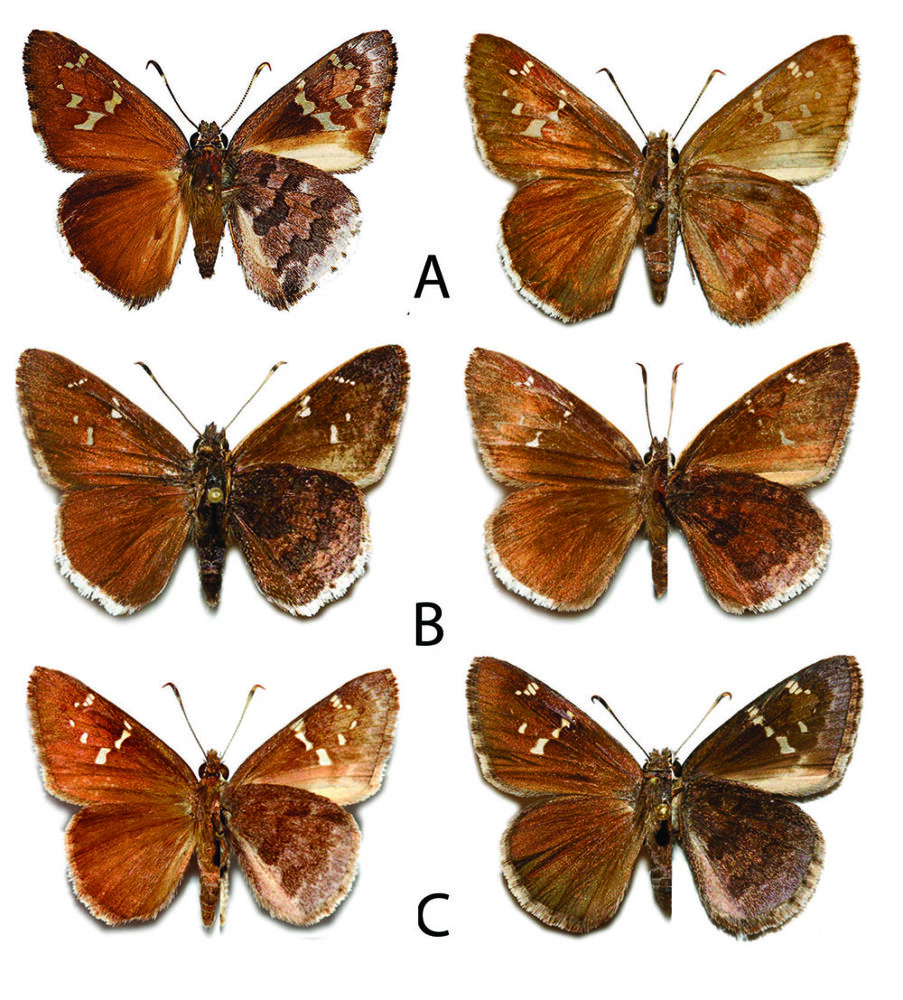
Glassy-winged Skipper (Xenophanes ruatanensis) Added June 14, 2025
Description. The medium-sized Glassy-winged Skipper is distinctive and aptly described by its common name. The median area of both FW and HW are inhabited by large translucent patches. No other butterfly currently known from NM has these distinctive patches. The apex of the FW is pointed, as is the tornus of the HW. The ground color is brown and there is a series of translucent spots near the apex of the FW. Range and Habitat. This species is tropical to subtropical and is a rare stray to NM. Its normal digs are from Argentina to northern Mexico, with occasional breeding in extreme southern Texas. Life History. Larvae feed on Malvaceae, including plants in the genera Malvaviscus and Malachra. Neither of these genera occur in NM, and it is unlikely that a stray would establish a breeding colony here using other Malvaceous plants. Flight. Glassy-wings probably fly year around in their normal habitat. Three broods have been recorded from Texas. Comments. We have one record of this species (as X. tryxus, a species recently found to be separate from ruatanensis and not known from the US) from Hidalgo County, Guadalupe Canyon, August. No other details are currently known. The species is not yet reported from AZ.
